|
DAVINCI - SACRED GEOMETRY
|
Leonardo da Vinci - Sacred Geometry |

Dodecaedron |
- Leonardo was a great painter,
scientist, engineer, architect and artist of the High
Renaissance.
- He was deeply involved in mathematics and
sacred geometry, and is the prime example of a universal genius
or Renaissance Man.
- Leonardo, who had superhuman skills
of the mind, learned about sacred geometry and he used it as a
mysterious process and underlying philosophy in everything he
did, including all his art, architecture and engineering
projects.
- His notebooks were not merely ideas and
sketches, they were filled with alchemical symbols and
geometric puzzles.
|
The High Renaissance was a period of significant artistic achievement in Italy, primarily during the early 16th century, roughly from 1490 to 1527. It's known for the work of artists like Leonardo da Vinci, Michelangelo, and Raphael, and is characterized by harmonious compositions, refined techniques, and a blend of idealism and realism. (Assistant)
|
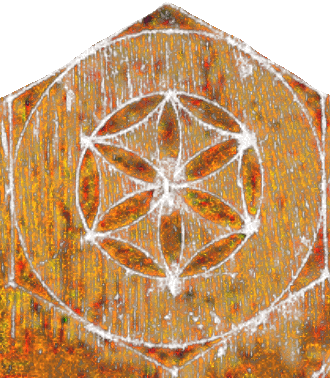
Barn raising |
- The church may have ruled the surface, but beneath the
brushstrokes, Renassance artists like Botticelli and Da Vinci
were part of a quiet revolution.
- A revolution that
blended faith with philosophy combined with hidden knowledge
into timeless masterpieces.
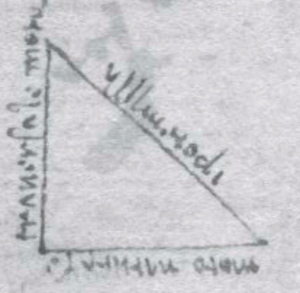
345 Triangle |
- The word geometry comes from Greek and means earth
measurement and the origin comes from Egyptian rope stretchers
in the shape of a 345 (Pythagoras) triangle.
- The
Egyptians would tie knots in the rope and formed the 345
triangle and used them to measure land boundaries after the
annual Nile flood.
- The practical application of using a
triangle to measure land led to its symbolic use.
-
Egyptians, Greeks and Romans may have used the word to mean
measurement of the curvature of the earth because they all
knew the earth was round.
|
It was only in the Middle Ages that civilization that
architects forgot this basic fact. Architects measured
the curvature of the earth by putting a stick in the
ground in two cities at the same time of day and they
would measure the length of the shadow cast and it was
different lengths based on the curvature of the earth.
From this they could use geometry to calculate the
circumference of the earth. (Roberts
Architecture)
|

Blooming |
-
In much of Europe, and especially Italy, the Renaissance was a time of
intense intellectual change.
- It was a time when the
medieval and modern were blended, so that humanism and
religion, science and magic, math and philosophy all bloomed
at once.
- Leonardo was intensely creative, and what we
call a polymath; he was interested in every subject and
always looking for connections in everything.
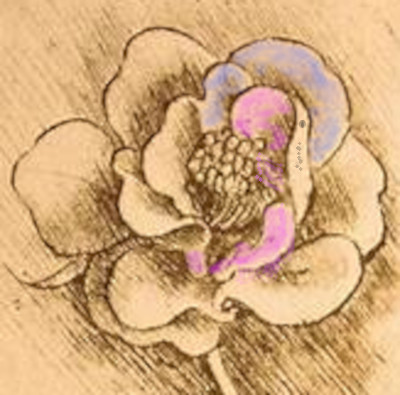
Smelling the roses |
- Even today, Da Vinci is still known mostly for his
paintings, and he was known for that during his life, and
after his death as well.
- It wasn't until the early
1800s that his extensive collection of notebooks were
discovered.
- As people began to go through them, they
realized that the scope of his thinking and his work went
way beyond art.
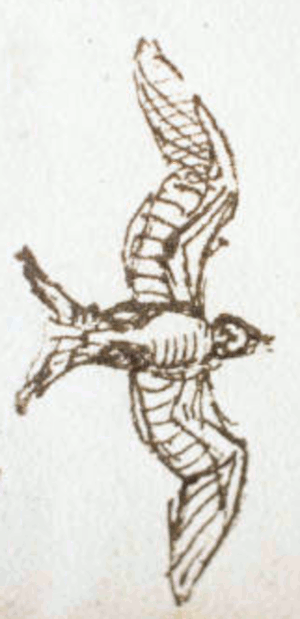
Aerodynamics |
- His work seemed to anticipate so many
scientific discoveries that were made in the centuries
following his death.
- The subjects he touched in
remarkable ways included aerodynamics, anatomy, biology,
engineering, medicine, architecture, optics, and many more.

Ashburnham |
- Da Vinci was born on April 15th, 1452, in the town of Vinci
in Italy.
- He was an artist,
mathematician, inventor, musician and a writer and his interest in the laws of science and nature
greatly influenced his work as a sculptor, painter and an inventor.
- At the age of 14 he
began apprenticing under Verrocchio, and for the next six years he learned many
technical skills including: metal working, leather arts, carpentry, drawing and sculpting.
- By the time Da Vinci turned 20 he had qualified as a master artist in the Guild of Saint
Luke and had started his own workshop.
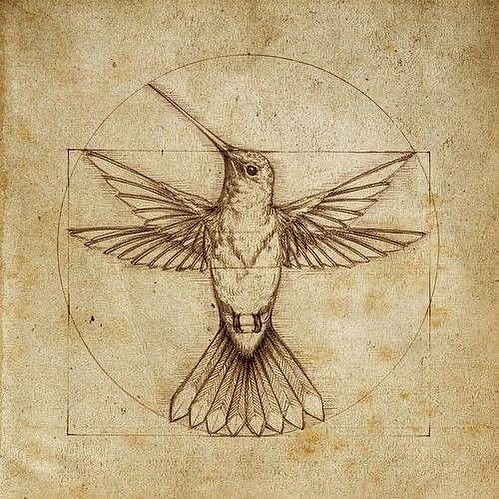
Leonardo Da VInci - 1490
Hummingbird |
- Why do we only seem to know Da Vinci
as an artist and painter, rather than a profound intellectual
who had his mind in everything?
- You find that the reason
for that was that Leonardo was very flighty you might say, he
worked like a bird, moving quickly from task to task, and
never hovered on one subject for very long.
- He was not
studying anything to become an 'expert' and write a book,
although technically he was (on everything), and filled many
notebooks, but he would pick things up and would leave them
behind just as quickly.
|
Avians appear in a number of the 13,000 notebook pages he produced, from the kite hawks of Codex Atlanticus (c. 1478) to his comparatively compact folio Codex on the Flight of Birds (c. 1505). It’s easy to attribute the master’s affinity for birds to his longing for the sky, but there’s evidence that he had a particular fondness for our feathered friends. (Vittoria Benzine)
|

Bright light |
- It also makes you wonder if Leonardo's light was so
bright it irritated others who weren't as high frequency as
him.
- Something we're learning more and more about
recently and generally what happens is the individual is
ignored, and then their ideas are all pilfered by the same
people ignoring them.
- A lot of individuals have prospered
from his creations, much more so than he ever did.
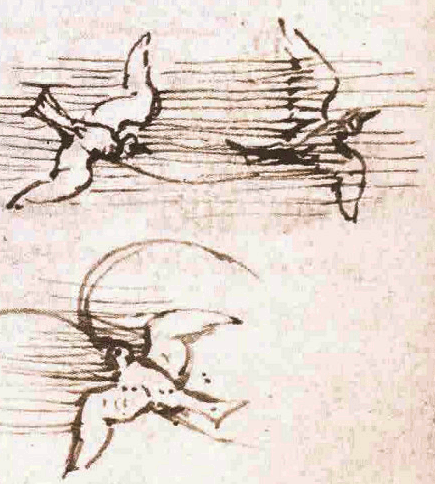
Codex on thr Flight of Birds |
- Da Vinci was not a literary book writer and the same as
his flighty bird-like study habits, his notebooks were never
organized and presented as anything ready to be published.
- The
same as his research habits, his notebooks flitted from one
adventure to the next and everything he created was simply
disorganized.

Design for horse statue |
- Throughout his life, he contemplated
writing many treatises and building many of his inventions,
however, he had a problem finishing what he started.
- Da Vinci was deeply interested in detail and process.
- Through his observations
and countless inventions during his life he recorded somewhere between 20,000 to
28,000 pages of notes and drawings.
- It is believed that he produced at
least 50 notebooks.
- Many of his drawings were created with black or red chalk, and others
with pen and ink on wash paper.

Some kind of flying device |
- By
looking at his notebooks you are able to see that there is an organized sense of chaos
while at the same time he was very detail oriented.
- Each page was limited to one idea, and when his ideas
exceeded one page he made note of it.
- The pages were filled with his interests and
experiments but almost never contained anything about his personal life.
-
His interests were varied and included human forms, animals,
mechanical inventions and flying machines such as the first ornithopter (with pedals).
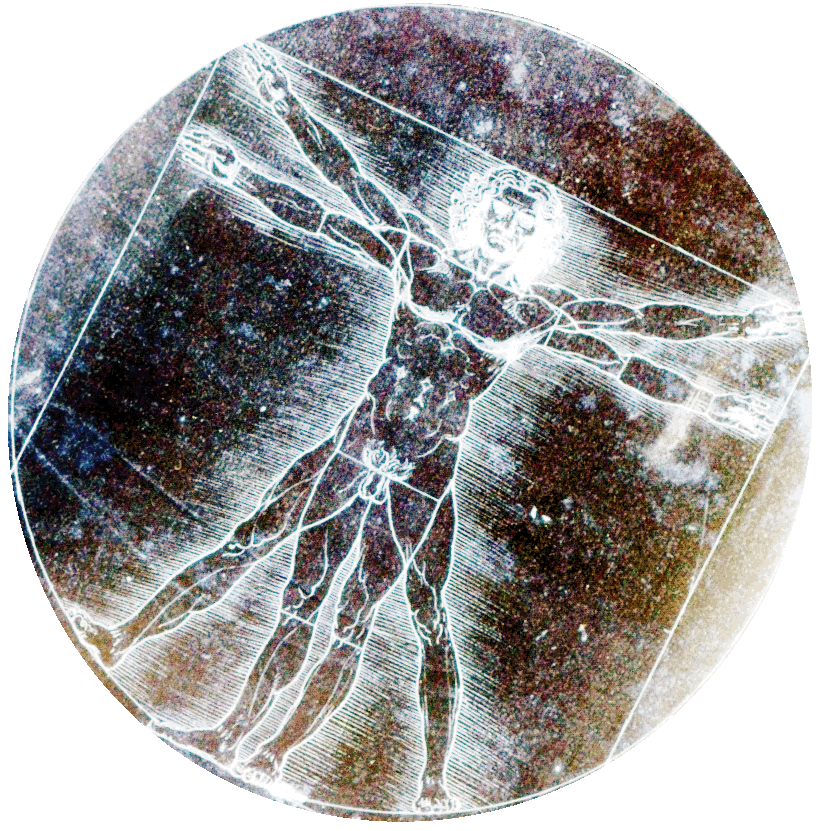
Vitruvian distracted |
- Some of this was due to circumstances, wars breaking
out, funding withdrawn; but a huge part of it was his own
tendancy to get bored and distracted by new thoughts.
-
This caused issues throughout his life, despite his talents,
he often ran into problems with patrons, family and his inner
self.
- The many notebooks he
compiled included plenty of to-do lists and future plans, all
which fell to the side.
- He would sometimes fall into
despair and wondered if 'anything was ever done? tell me, tell
me."
|
Dimmi, dimmi... se mai fu fatta cosa alcuna... (Da
Vinci, Codex Atlanticus)
|
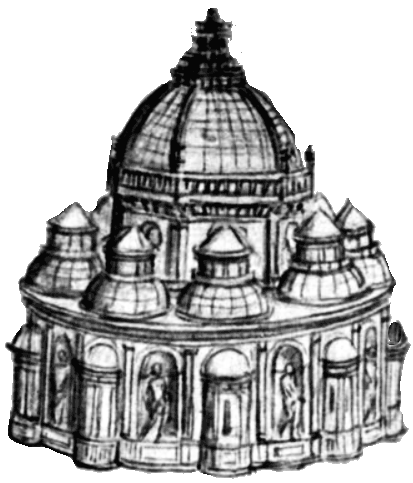
Central church design
1488 |
- It didn't help that Da Vinci left his life's work
to his assistant Francesco Melzi who he asked to help organize and maintain
his vast notes, something he was apparently not able to do
because he was too busy researching and inventing.
- Although Melzi made a further mess of things by
attempting some kind of organization.
- After Melzi passed on, his descendents sold part of the
work in a random fashion.
- It's estimated that about 1/3 of Da Vinci's work is now
published and the rest seems to be lost.

Central church floorplan |
- There was a secret behind Leonardo's mysterious process
of creating so many things and that was sacred geometry.
-
He used it to organize everything he worked and as an
underlying principle in art, architecture and engineering.
- The secretive tradition of sacred geometry centers on
numbers, harmony, geometry and cosmology.

Ancient curriculum |
- Sacred geometry goes way back to ancient times to Egypt,
Babylon, India, Greek and Roman civilizations.
- You can
see it in use in all the circles in Stonehenge and the Greek
and Roman temples throughout the ancient world.
-
Architects during the Middle Ages and the Renaissance studied
the liberal arts.
- This included subjects such as
arithmetic, geometry, harmonics and astrology.
- Much of
what we think of today as sacred geometry comes from this
ancient curriculum.
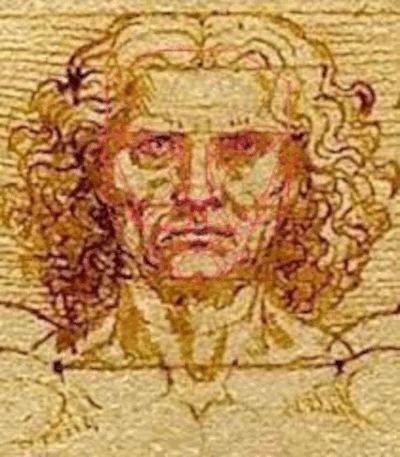
Leo |
- Like modern day architects, Leonardo used geometry in
the design process, but unlike modern geometry there was no
clear division between pure geometry, harmonics and astrology.
- It was all one science because these concepts were all
considered interrelated and were called 'The Music of the
Sphere.'
- This is the belief that the universe isn't
created by particles, as science thinks, but rather by
vibrations that create cyclical patterns.
- Artists and architects of the period tried to
incorporate harmonic proportions of the cosmos into the work
of art and architecture.
|
For centuries, scientists and philosophers
believed that the universe was a stately, ordered
mechanism, mathematical and musical. The perceived
distances between objects in the sky mirrored (and
were mirrored by) the spaces between notes that formed
chords and scales. The smooth operation of the cosmos
created a divine harmony that composers sought to
capture. (Jamie James)
|

Ignorant of geometry |
- The new age idea that all consciousness is based on
sacred geometry and consciousness creates reality is based on
the modern science of quantum mechanics.
- But this is
different than the ancient belief that sacred geometry and
musical number ratios are manifestations of the universe
vibrating.
- Vibration to Plato was akin to the orbits of
our souls.
- Number, music, geometry and astrology are the
four great liberal arts of the ancient world.
- The
practice of geometry facilitated the evolution of the soul.
|
Let none ignorant of geometry enter here.
(Plato)
|
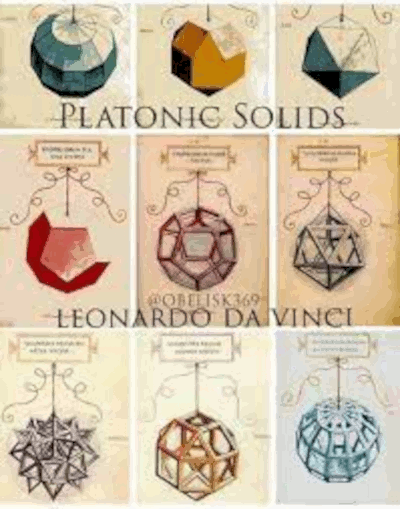
Universal system of knowledge |
- Ancient science was one universal system of knowledge
where astrology, Kabbalah, sacred geometry, chakras, angelic
magic, harmonics and music, were all manifestations of this
vibrating universe.
- Science for thousands of years
thought the fundamental nature of the world is knowable
through a pattern of waveforms.
- These could be understood
through mathematical and geometric harmonies.
|
Kabbalah focuses on Jewish mysticism, the nature of God, and the universe, primarily within the context of Jewish theology.
Texts like the Zohar, a central Kabbalistic text, do not mention or discuss Jesus. (Assistant)
|
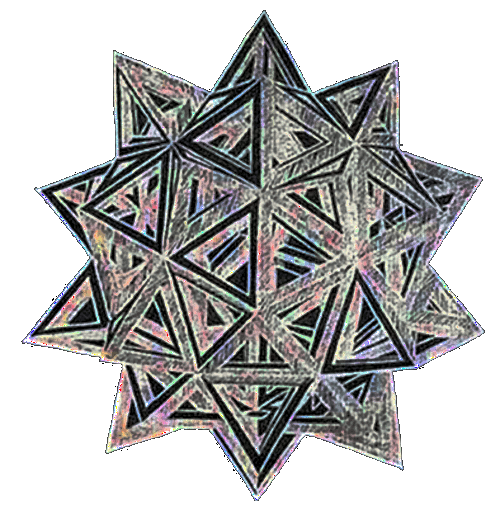
Power of art and architecture |
- The power of art and architecture was thought of as a
from of medicine helping restore tranquility and allowed for
healing to take place through music and art.
- It was
medicine because it promoted order, harmony and wholeness and
artists, musicians and architects were viewed as contributing
to health by creating harmonious works.
- From this we can
see geometry, architecture and the sacred all mix into a
holistic science of everything.
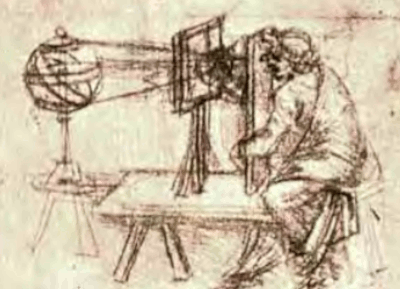
Self taught |
- Leonardo was not formally educated, but instead was
self-taught using an almost scientific method of observation
to learn and grow throughout his life.
- In order to
understand Da Vinci, you must understand sacred geometry and
how he used it in his work.

Sforza's court |
- Da Vinci entered the court of Ludovico Sforza, Duke of
Milan, in 1482.
- Among
his many accomplishments while in Milan was his role in the reconstruction and decoration of Castello Sforzesco,
- A grand castle that was the seat and residence of the Duchy of Milan
in Sforza’s court.
|
Leonardo’s interest in flight appears to have stemmed from his extensive work on military technology which he performed in the employ of the Milanese court.” The artist made his first flying machine drawings in the 1480s, while serving as painter and engineer to Milanese duke Ludovico Sforza. Leonardo returned to Florence in 1500, the year after Sforza lost power, then went to Rome to serve as senior military architect and engineer to the son of Pope Alexander VI.
(Peter Jakab)
|
|
Vitruvius |
|
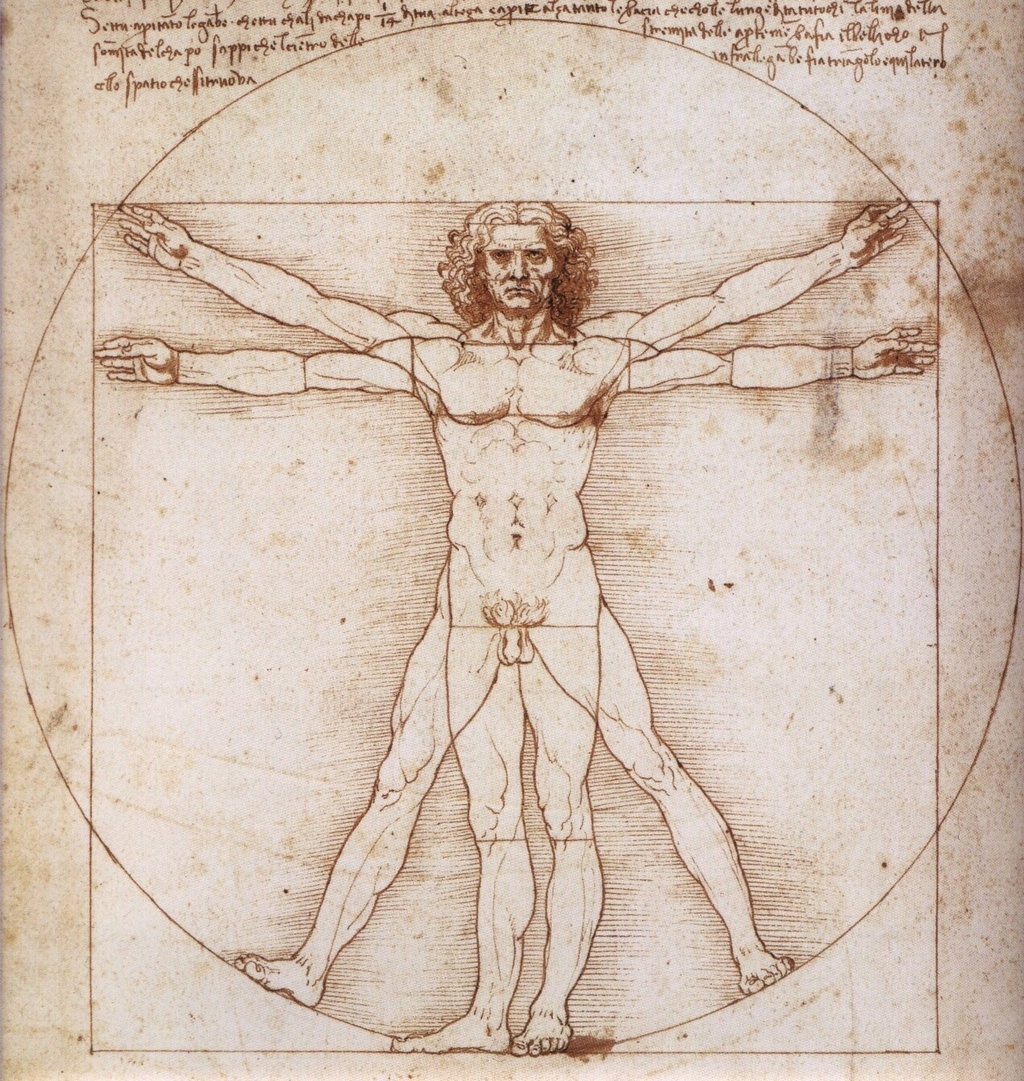
Leonardo da Vinci, Public domain, via Wikimedia Commons
1487-90
Exposing everything!
|
- Da Vinci was very familiar with
classical authors like Vitruvius, whose work he knew in detail
and admired.
- He emulated this Roman polymath and
considered him his mentor after studying a text written by
Vitruvius called
De architectura, which is the first book on
architecture that still survives today.
- The English
version is called, Vitruvius The Ten Books on Architecture.
- From this
study, Leonardo was able to bring forward
concepts of angles and distance.
- Also, the replacement of
ideals, such as cubit arm length or man's foot, with precise,
specific measurements.
|
Vitruvius (c. 80–70 BC – after c. 15 BC) was a Roman
architect and engineer during the 1st century BC,
known for his multi-volume work titled De
architectura. As the only treatise on architecture to survive from antiquity, it has been regarded since the Renaissance as the first book on architectural theory, as well as a major source on the canon of classical architecture. (Wikipedia)
|

Marriage of heaven and earth |
- The circle represents heaven while the square
represents earth.
- Squaring the circle symbolically
represents the marriage of heaven and earth.
- Leonardo's
Vitruvian Man represents the nexus between both.
- Proportions in a man's body and used extensively in architecture,
are the same symbolically as the divine proportions of heaven.
- Architects in the Middle Ages used the dimensions of the
human body to lay out the floor plans of their cathedrals.

Vesica piscis |
- The circle is the symbol of the first creation of the
cosmos and the totality of manifest creation.
- It starts from a
single point and spreads out to infinity.
- Two circles
create the Vesica Piscis, or fish bladder, this is the symbol
of the second day of creation.
- Christ is often depicted
inside this symbol and early Christians drew it in the sand as
a secret sign during the period when Christianity was outlawed
by the Roman Empire.
- The fish has become a universal
Christian symbol and architects have been using this geometry
for many ages.
- This is the cosmic womb, the Vesica
Piscus, a sacred geometric shape representing the intersection
of heaven and earth.
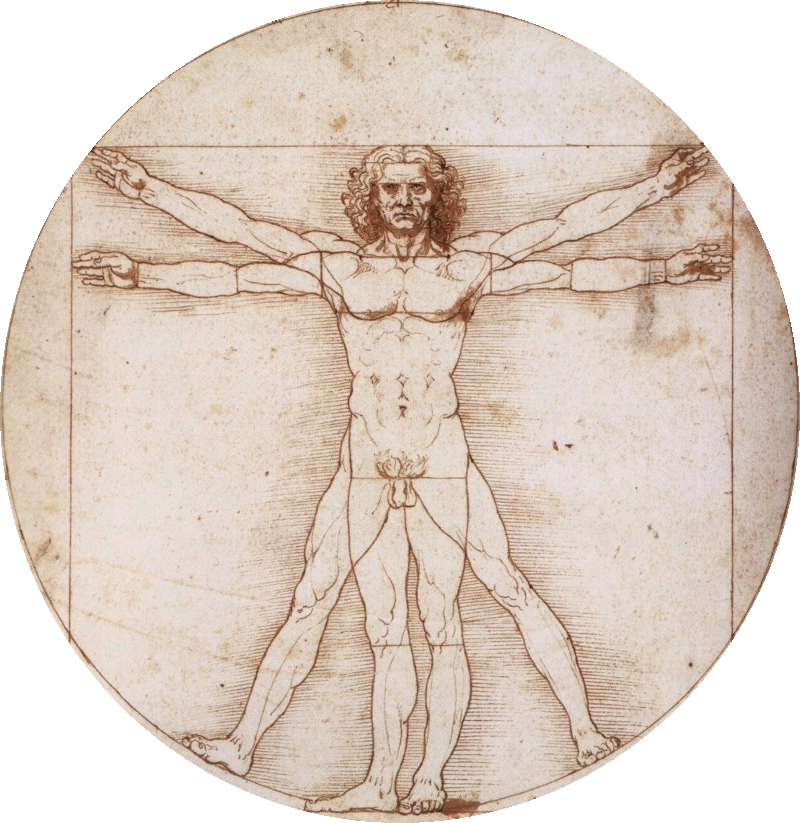
Vitruvian
Man in the light |
- In
the Vitruvian Man sketch, Leonardo brought to life the classical author's ideas
of a perfectly measured human.
- It is often
referred to as a Cannon of Proportions because of its correlation with the ideal human
proportions.
- The design comes directly
from Vetruvius'
De architectura.
- It holds to the same virtues and geometries of
Euclidian elements, and notably the square and circle.
- At one time, Da Vinci
planned to write a commentary on Vitruvius, although he
unfortunately never
got around to it.
- There has been a lot of debate whether
Leonardo hid various Da Vinci Code type cues, hints
or encryptions having been drawn intentionally.
|
Certain contentions build upon an understanding that Leonardo da Vinci indeed did encode such type bits within his Vitruvian Man schematic for addressing mathematical symmetries & patterns suspected to occur naturally, as well, within the non-physical realm; to a mental or psychological realm.
(Craig Matheson)
|
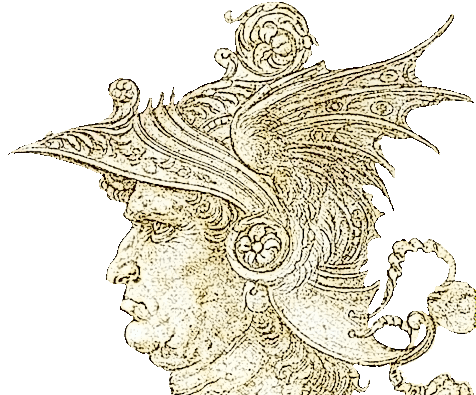
Military man |
- Da Vinci was not usually thought of as a military man,
but he was no stranger to putting his mind to matters of war.
- His interest in military engineering
began with the Sforza court dating back as far as 1482-83.
- This is when he wrote a letter of presentation to Ludovico il Moro,
the Duke of Milan from 1494 to 1499, emphasizing his capability in military
engineering.
|
Castello Sforzesco. The castle has an imposing and iconographic aspect which makes it one of Milan's landmarks. During the Renaissance it was the residence of Milan's Duke Ludovico Sforza. Leonardo worked there as a military and civil engineer and only later as an artist. (Assistant)
|
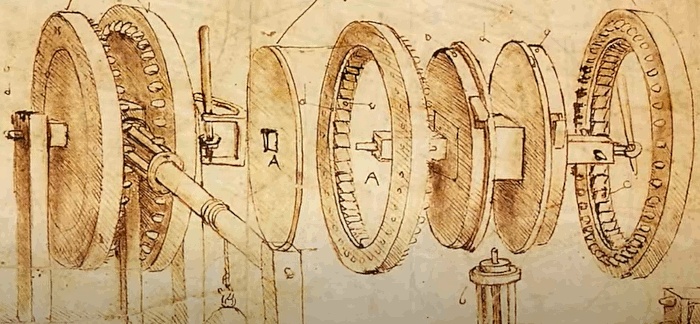
Engineering and machine studies |
|
- Over half of Da Vinci's surviving drawings are of
engineering and machine studies and during his life, he
considered himself more of an engineer than an artist.
-
Much of his engineering skills came from studying Vitruvius'
geometry.
- He was able to analyze many engineering
machines like the Archimedes' water screw that was used to
drain irrigated fields.
-
Archimedes was an ancient Greek mathematician and engineer
from Syracuse in Sicily.
- Leonardo used geometry to work
out gear ratios for his machines and to study the moving
parts.
|
Archimedes is considered one of the leading scientists in classical antiquity, and one of the greatest mathematicians of all time.
He anticipated modern calculus and analysis by applying the concept of the infinitesimals and the method of exhaustion to derive and rigorously prove many geometrical theorems, including the area of a circle, the surface area and volume of a sphere, the area of an ellipse, the area under a parabola, the volume of a segment of a paraboloid of revolution, the volume of a segment of a hyperboloid of revolution, and the area of a spiral. (Wikipedia)
|
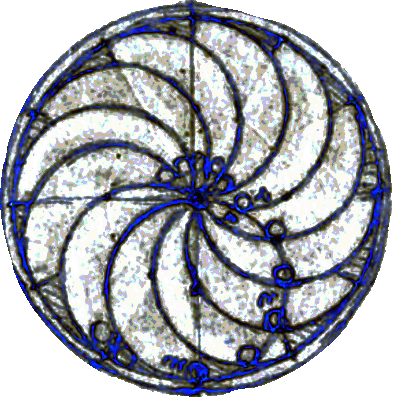
Geometry in machinery |
|
- What makes Da Vinci truly amazing is his polymath
approach to engineering because by applying geometry to
machinery, he was able to rediscover Archimedean geometry.
- It's clear that Da Vinci studied
Archimedes and used his geometrical theorems to design
mechanical inventions.
- Archimedes wrote the text on
spirals around 225 BC and Leonardo may have learned about
these spirals first through Vetruvius before experimenting
with them extensively.
- Archimedean spirals can't be built
exactly using a ruler or compass and were perhaps built
through physical models or prototypes.
|
Leonardo applied Vitruvian geometric concepts to the machines he designed and these included, squaring the circle, golden ratios, circles and spirals. (Roberts Architecture)
|

Theoretical geometry |
|
- Leonardo spent much of his time studying geometry and
applying it to his inventions.
- It's clear from his
notebooks that he played around with theoretical geometry and
used it in architecture, decorative designs and engineering.
- One application was the creation of centers for arches and
this the wood forms that supported the arches during
construction.
- Leonardo created many drawings
demonstrating how the load of arches are transferred through
the wood supports called centers.
- This involves squaring
a circle or calculating the horizontal and vertical forces
through a rounded arch.
|
Da Vinci's theoretical geometry focused on applying geometric principles to art, architecture, and engineering, often drawing inspiration from "sacred geometry". He explored concepts like proportion, perspective, and the relationships between geometric shapes, including the Platonic solids. His work demonstrates a deep understanding of geometry and its practical applications, even if his approach was sometimes intuitive rather than strictly mathematical. (Assistant)
|

Aerial screw |
|
- Da Vinci drew his design for an 'aerial screw' in the
late 1480s, while he was employed as a military engineer by
Ludovico Sforza.
- This was one of several aerial machines drawn by Leonardo, including an early parachute, an ornithopter and a hang glider.
|
The pen-and-ink sketch outlines an idea for a flying machine similar to a modern helicopter, with a spiral rotor or "aerial screw" based on a water screw, but intended to push against the fluid of the air instead of water. (Wikipedia)
|

Flying machine |
|
- Among the many things been playing on his mind, at the top of the list was his obsession with flying.
- He focused on studying the anatomy of birds and their flight techniques to design his famous flying machines.
|
A bird is an instrument working according to mathematical law, which instrument it is within the capacity of man to reproduce with all its movements, but not with a corresponding degree of strength, though it is deficient only in the power of maintaining equilibrium.
(Da Vinci)
|

Winged |
|
- After months of in-depth studies, Leonardo was ready to design his most famous and complex flying machine, called Grande Nibbio (the great kite bird).
- He also performed a practical experiment building a prototype.
|
Codex on the Flight of Birds (c. 1505) marked his first foray into studying the way birds really fly—and how their aerodynamism might translate into mechanical flying machines. He had the revelation to focus on suspension rather than propulsion. Later innovators barely heard of his work. Scholars only recently proved that he discovered the principle of dynamic soaring 400 years before Lord Rayleigh did.
(Vittoria Benzine)
|

33-barrel organ |
|
- The 33-barrel organ, or gun, was another of Da Vinci's inventions that was never built.
- In some ways, it resembles a modern machine gun.
- It
consisted of 33 small guns mounted on a revolving frame so it
was an early type of rapid-fire machine because the frame could
be turned to fire a second round.

Robotic knight |
|
- Under the patronage of Sforza, Da Vinci invented a 'robotic knight' that could wave its arms, move its neck, and even open and close its mouth.
- This strange doll was controlled externally by cables operated with a hand crank, as well as by an internal, gear-driven machine.
- About 450 years after he designed his robotic knight, his detailed sketches of the invention were rediscovered.
|
In the early 21st century, one roboticist took a page from these notes in designing an anthropomorphic robot for the modern age. Mark Rosheim, a roboticist who has built robotic systems for NASA and Lockheed Martin, built a working model of da Vinci's robotic knight in 2002. (Elizabeth Palermo)
|
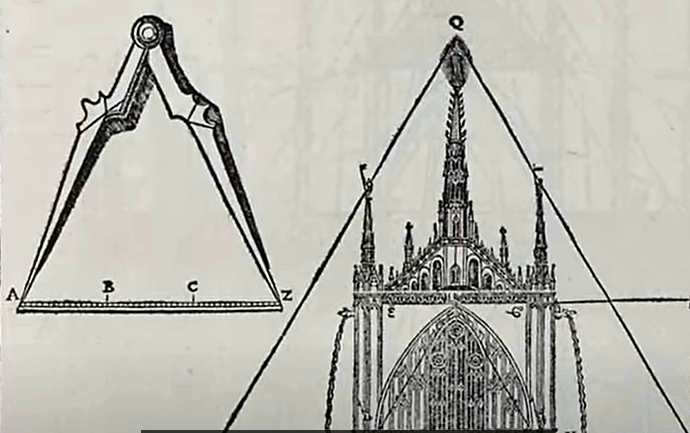
Vitruvius text |
|
- Vitruvius is a must read for all architecture students,
even today.
- His writings were revived and republished in
the 1400s creating a Roman revival in architecture.
|
The belief that a god created the universe to a geometric plan has ancient origins. Plutarch attributed the belief to Plato, writing that “Plato said God geometrizes continually”.
In modern times, the mathematician Carl Friedrich
Gauss adapted this quote, saying “God arithmetizes.”
(Goldstein et al., 2007) .
|
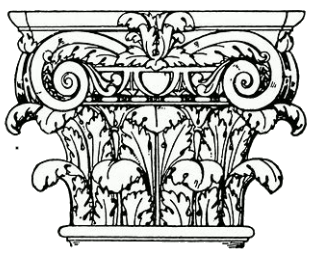
Roman Composite capital |
|
- The
word Renaissance means revival and what was being revived was
Roman, Greek and Egyptian ancient knowledge.
- The most
fundamental Roman knowledge was engineering and they were
renowned for their construction feats from the aqueducts to
arches, and domes made out of concrete.
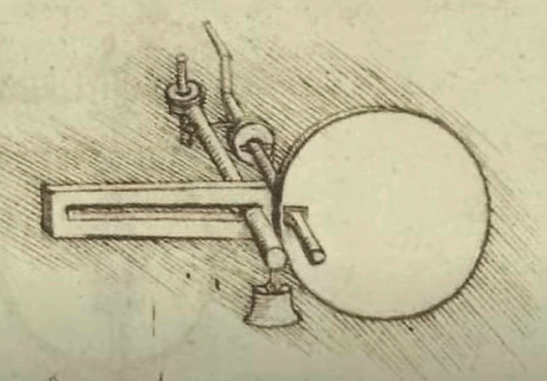
Inventive |
- Leonardo, like other scientists of the time, was
trying to rediscover ancient Roman science and technology.
- It lay all around them in ruins and they tried to piece it
together to form a new science.
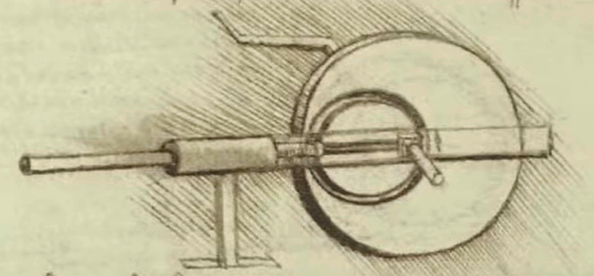
Leonardo's Own interpretation |
- Leonardo can be seen in this light as trying to revive
Vitruvian and Roman technologies, while still being inventive
and coming up with his own interpretations based on
observation and experiment.
- One of the sources for
Vitruvian mathematics is Euclid's book on geometry called Euclid’s Elements,
written around 300 BC.
- It is perhaps the most important
work of mathematics ever written.
- Euclidian geometry is
the fundamental source for much of Vitruvian engineering and
was used in art and architecture.
|
Pacioli |

Divina Proportione |
- The only sketches of Da Vinci's that were ever published
during his life were his 3D drawings of platonic solids and
geometric shapes.
- These were published in 1509 in Pacioli's
Divina Proportione, a book on mathematics written by Fra Luca Bartolomeo de Pacioli, a Franciscan friar, in 1497 at the court of Ludovico Sforza, Duke of
Milan.
- Sforza had invited Pacioli to Milan to teach mathematics at his court, and it is here that two great minds of the Renaissance met.
|
Pacioli, a mathematician and tutor originally from Tuscany, was invited by Sforza to join the court in 1496. By this time Pacioli had trained under artists and mathematicians such as Piero della Francesca and Leon Battista Alberti and taught mathematics at several of the ancient Italian universities. He published his first major work, a textbook for use in the schools of Northern Italy, in 1494. (thinking3d.ac.u)
|
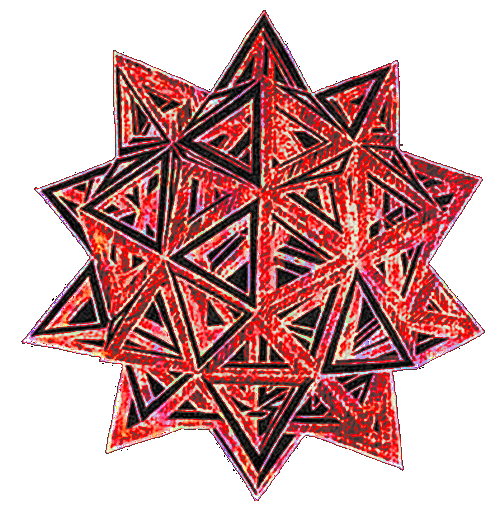
Geometric shapes as art |
- Leonardo and Pacioli quickly became close friends.
- About 1507, some 20 years after Leonardo created his
Vitruvian Man, Pacioli tutored the artist in Euclidian geometry and Leonardo impressed the mathematician with his ability to depict intricate geometric shapes as works of art.
- Much of Pacioli's book came from mathematical concepts
developed by Fibonacci.
- The book is about mathematical
proportions in their applications to geometry, art and
architecture.
|
The universal arithmetical tool of literate Italian people in the Renaissance was the Rule of Three, also known as the Golden Rule and the Merchant's Key. (renaissanceperspective.eu)
|

Platonic solids and geometric shapes |
- Da Vinci's most successful sketches were his 3D drawings of platonic solids and
geometric shapes.
- He contributed about 60 illustrations
and this is what led him down an intellectual rabbit hole to
discover ancient geometry and how it can be used for practical
purposes, and perhaps even for the secret and mystical.
- Plato (d. 348 BC) envisioned the world as wrapped in a loving soul to mediate the Platonic Forms.
|
The printed Divina Proportione includes 59 leaves illustrated with full-page woodcuts of solid and open geometric forms after Leonardo da Vinci’s drawings done in 1497. It also includes a further 23 leaves of the geometrical shaping of Roman capital letters and the text is illustrated throughout with woodcuts of Pacioli’s theorems. (thinking3d.ac.u)
|

Textbook art |
- Leonardo's drawings helped make Pacioli's
Divina Proportione, a popular book and helped popularize
the Golden Ratio.
- Pacioli used the terms sacred ratios or
divine proportion and the second half of the book he discusses
Vitruvius and his ideas about architecture.
- Many of
Da Vinci's ideas about anatomy
and biology would have been enormously advantageous for
humanity had they been published earlier.
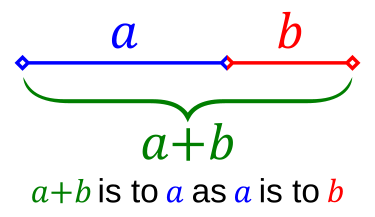
Traced by Stannered, Public domain, via Wikimedia Commons
Golden Ratio |
- The Fine Structure Constant, the Golden Ratio (Phi) and Fibonacci Sequence are governing the laws of physics and all shapes in reality.
- Pacioli’s text made the golden ratio central to the
understanding of painting, sculpture, architecture, music,
poetry and philosophy and was illustrated by models drawn by
Leonardo.
|
Pacioli spent much of his time in 1497 composing the text of Divina Proportione, which is an in depth
study of the golden ratio, or ‘divine proportion’ [a :
b = b : (a + b)], in geometry and art and which also
detailed Euclid’s regular and semi-regular Platonic
solids and concludes with a treatise on perspective
and architecture. Pacioli’s text made the golden ratio
central to the understanding of painting, sculpture. (thinking3d.ac.u)
|
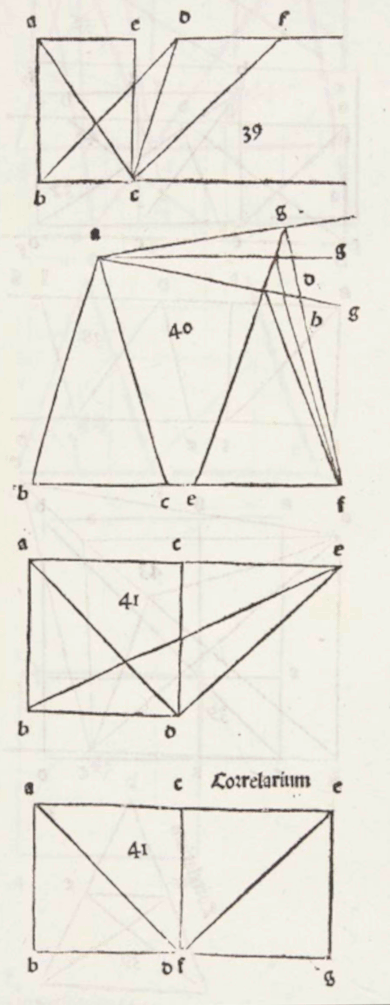
Pacioli's Euclidian geometry |
-
Both Leonardo and Pacioli were forced to flee Milan together in December of 1499, when Louis XII’s army invaded the Duchy.
- They first traveled to Mantua, then Venice and then finally Florence where the pair shared a house until 1506.
- In 1509, Pacioli returned to Venice to oversee the printing
of both Divina Proportione and his Latin translation
and commentary of Euclid’s Elements.
|
When Luca and Leonardo left for Milan heading for
Florence in 1499, they carried with them all this
knowledge. The “Divine Cut” was by now called Divine
Proportion or the Golden Mean and it was this, which
entered into the Italian Renaissance and set into
motion revolutions in science, and the arts.
(Dey, 2012)
|

Kwamikagami, CC0, via Wikimedia Commons
Pacioli's Trajan font |
- Pacioli also designed the classic Roman alphabet known
as Trajan font.
- Around the beginning of the 16th century several
other authors published designs for uppercase characters.
-
Pacioli preceeded the other authors in 1497 with his Trajan
font.
- His letter
shapes were the best basic form in the subsequent development of uppercase fonts.
|
Albrecht D¨urer
who wrote On the Just Shaping of Letters which was published in Nuremberg in
1525, and Geofroy Tory who wrote Champ Fleury which was published in Paris
in 1529. Fra Luca Bartolomeo de Pacioli preceeded by of these by developing his
recipe for uppercase characters in 1497 and which was published in De Divina
Proportione at Venice in 1509. (Peter Wilson, Herries Press)
|
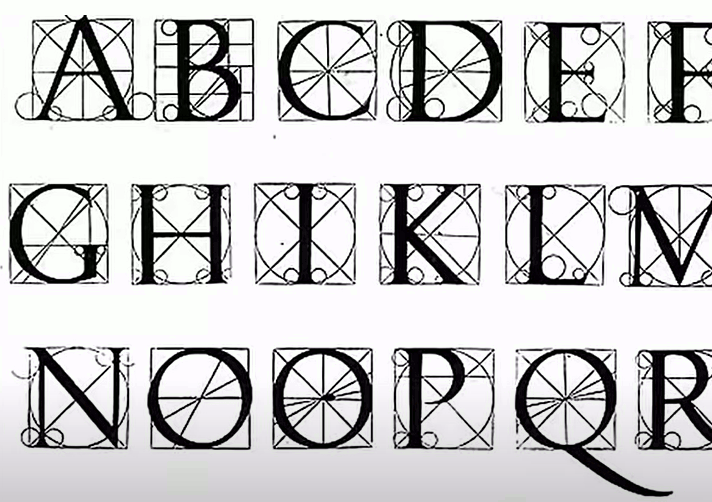
Pacioli font art |
- Pacioli drew this architectural font with a ruler and compass.
- He used
his ideas about divine proportions in the font which was
featured in De Divina Proportione, completed by
February 9th, 1498 in Milan and first printed in June 1,
1509.
- Pacioli and Leonardo apply the mathematical Golden Ratio to visual arts, architecture, alphabets, geometric figures and structures.
- The mathematicians of antiquity and the Greek philosophers were fascinated by this ratio, which appeared to reflect perfection and divine harmony.

Trajan Column |
- Many typographers rank the capitals carved on the Trajan column in Rome,
dated at 114 AD, as the high point of the Roman’s artistic legacy.
- The Trajan Column, built in Rome in the second century, is ancient by any definition, an artifact of a long-gone empire.
- Unless you read Latin, you can’t read its inscription, but even still it feels close and familiar, beautiful and harmonious.
|
Romans had many different styles of
letters—for business transactions, taking notes,
marking graffiti on walls. But the monumental capitals
of Roman inscriptions—broad shapes of C D G H O N
contrasting with the narrow B E F P R S—are what we
associate today with the Roman Empire. (Jaime Green)
|
|
Pythagoras |
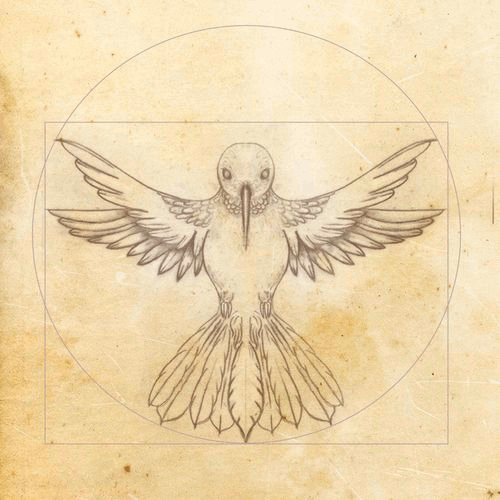
Numbers in everything |
- An early mystical secret society, the ancient
mathematician Pythagoras and his ultra secretive followers,
the Pythagoreans, were obsessed with the idea that reality was
literally made of numbers.
- Comparable to an ancient
version of the matrix.
- They didn't just study numbers,
they worshiped them and had secret handshakes, took mystical
vows of silence and believed in reincarnation.
- Members
wore a secret pentagram to identify each other.
- Pythagoras wasn't just a mathematician,
he was a mystic and a philosopher and he saw the code of
existence.
|
In nature we find patterns, designs and structures from the most minuscule particles, to expressions of life discernible by the human eyes, to the greater cosmos. These inevitably follow geometrical archetypes, which reveal the nature of each form and its vibrational resonances.
(Rawles, 1997)
|
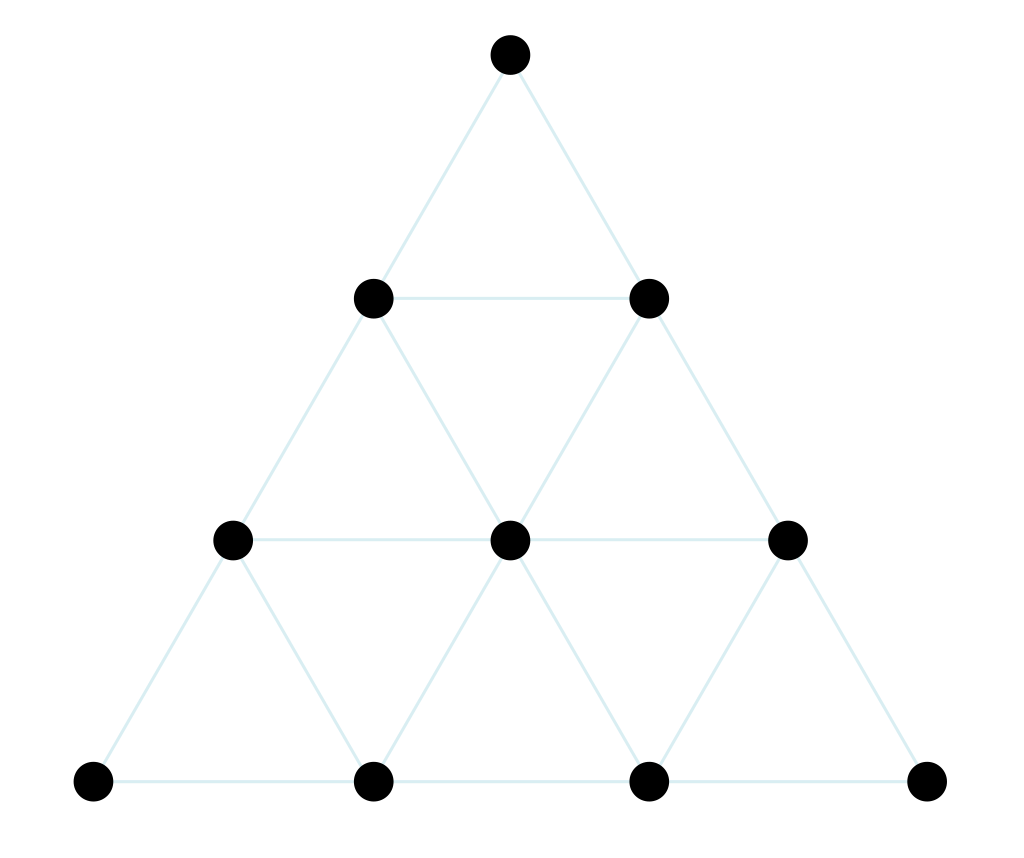
Jossifresco, Public domain, via Wikimedia Commons
Tetractys
1+2+3+4 = 10 (wholeness and completion) |
- The Pythagoreans taught at the deepest level, that
everything is interconnected by cosmic harmony and divine
order.
- Their most sacred symbol was the tetractys which
was a shape formed by 10 dots arranged in a perfect triangle
and this represented everything coming from One.
- At the
top of this sacred symbol was a single dot, representing
ultimate unity; from that one came two, from two came three,
and finally from three giving four.
|
The tetractys is a triangular figure consisting of ten points arranged in four rows: one, two, three, and four points in each row, which is the geometrical representation of the fourth triangular number. As a mystical symbol, it was very important to the secret worship of Pythagoreanism. There were four seasons, and the number was also associated with planetary motions and music. (Wikipedia)
|
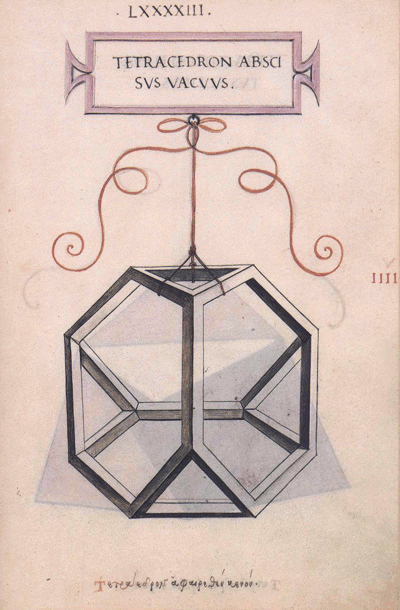
Tetracedron |
- The tetractys was a map of the universe, a triangle of
power and the original pyramid of meaning and to the
Pythagoreans, it was a blueprint of reality.
- Giving birth
to all creation, each row represented a level of creation.
- Starting at the top of the four levels of creation was unity
(divine source), then polarity (separation), harmony (the
synthesis) and at the base, manifestation (physical world).

Cosmos unfolding |
- According to the Pythagorean mystics, the entire cosmos
unfolded from unity into multiplicity.
- He beleved that
numbers were not just for counting, they were existence
itself, and he saw the entirety of existence as numbers.
- Pythagoras matters
because his obsession with everything emerging into One didn't
stay locked inside his secretive math cult.
- His ideas
opened the cosmic door for an even more radical philosophy
that came later called Neoplatanism.
|
The Pythagoreans literally swore secret oaths to the tetractys, convinced that it held the key to understanding the entire universe, all reality, every particle, person and planet, and that it all flows from one unified source. (MorgueOfficial)
|
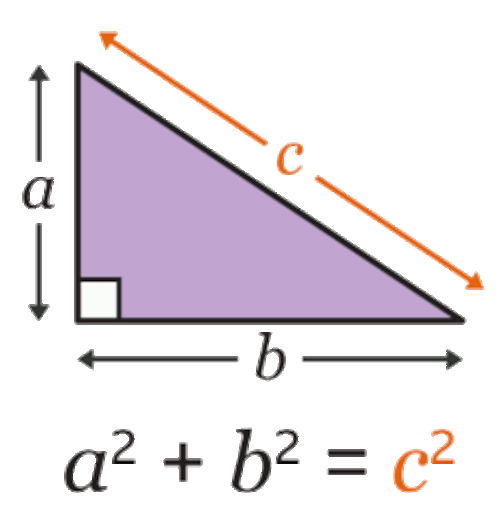
Pythagorean theorem
|
- In mathematics, the Pythagorean (Pythagoras') theorem is a fundamental relation in Euclidean geometry between the three sides of a right triangle.
-
The Pythagorean theorem is a cornerstone of math that helps us find the missing side length of a right triangle.
- In a right triangle with sides a, b, and hypotenuse c, the theorem states that
a² + b² = c².
- The hypotenuse is the longest side, opposite the right angle.

Wapcaplet, CC BY-SA 3.0 , via Wikimedia Commons
Pythagorean theorem
a² + b² = c² |
- Which can also be expressed in this manner as the square
root of each side shown as squares.
- The theorem states that the area of the square whose side is the hypotenuse (the side opposite the right angle) is equal to the sum of the areas of the squares on the other two sides.
- In other words, the two small squares (a+b) are equal in
size to the larger square (c).

Alvesgaspar, CC BY-SA 3.0 , via Wikimedia Commons
Animation showing another proof by rearrangements
a² + b² = c² |
- Various proofs use rearrangment of the elements of the
triangle and its squares by showing congruent ways to help
understand their size.
- Da Vinci
proved Pythagorean Theorem with the solution
a² +
b² =
c².
- Watch:
Pythagorean Theorem V (visual proof; Leonardo da Vinci).
|
All is number. (Pythagoras)
|
|
Plotinus |
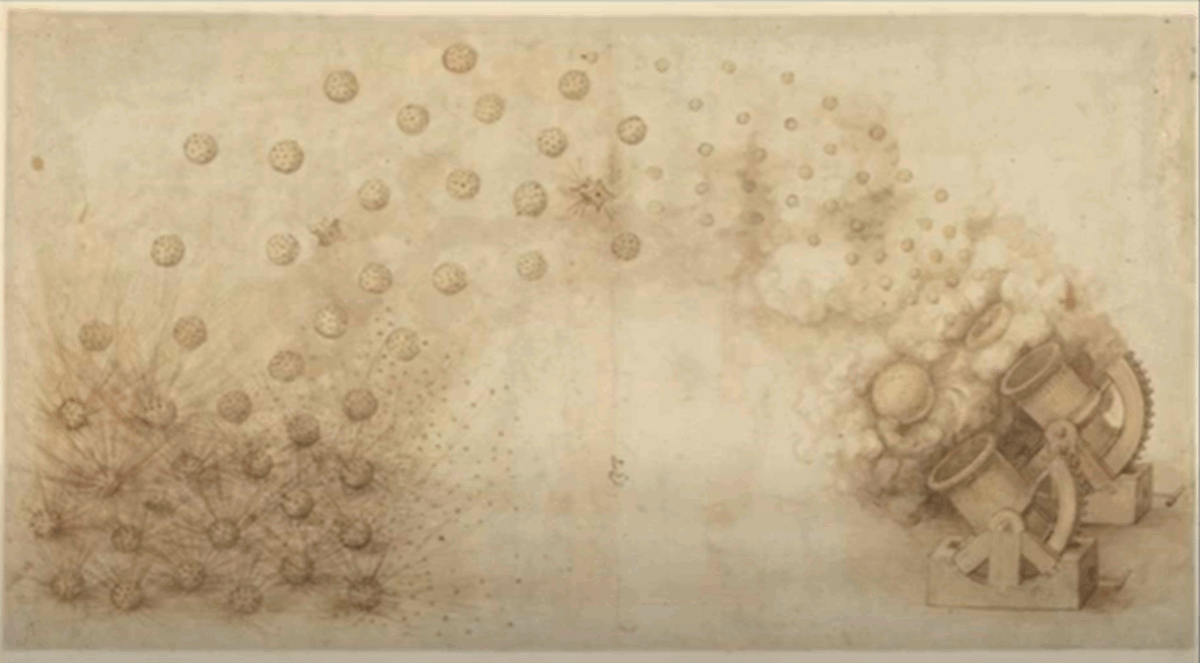
Explosive philosophy |
- Neoplatanism is this explosive philosophy championed by
the legendary Plotinus.
- While Plotinus considered himself a faithful interpreter of Plato's doctrines rather than an innovator, his interpretations and elaborations significantly shaped the development of Platonism, leading to the designation
'Neoplatonism' by later scholars.
- Plotinus' most notable
literary work was called the Enneads and outlined this
philosophical system.
- In his metaphysical writings, Plotinus described three fundamental principles: the One, the Intellect, and the Soul.
- Neoplatonism is a later development in the Platonic philosophical tradition.
|
Plotinus
was an ancient mystic, philosopher, rock star, and he
regularly had ecstatic experiences of merging directly
with the divine. Seriously, this guy didn't just
theorize, he lived it. He laid out an entire structure
of reality as emanating from something and he guesses
to what it's called, the One.
Plotinus says it literally beyond words, beyond
existence itself, just pure undiluted unity. So how
does this cosmic unity actually unfold into the messy
reality around us? Just like the Gnostics and
Kabbalists, Platinus described it like a divine
cascade pouring forth in layers. (MorgueOfficial)
|
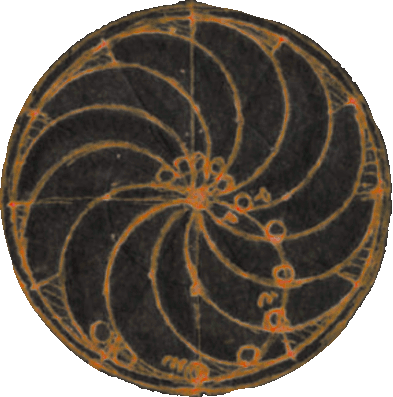
Merging back into One |
- Key aspects of Plotinus' Neoplatanism include four major
points.
- The One: A supreme, transcendent principle, beyond all categories of being and non-being, the source of all existence.
- Emanation: The process by which reality flows or 'emanates' from the One in a series of levels, such as the Intellect (Nous) and the Soul.
- Contemplation: A central practice for souls to ascend back to the One and achieve mystical union (henosis).
- Importance of virtue and dialectic: These serve as aids in the soul's ascent towards the One.
|
His works have inspired centuries of pagan, Jewish, Christian, Gnostic, and early Islamic metaphysicians and mystics, including developing precepts that influence mainstream theological concepts within religions, such as his work on duality of the One in two metaphysical states. (Wikipedia)
|

Wedding cake |
- Plotinus taught that the entire point of your life is
nothing less than returning inward and upward, consciosly
merging back into that infinite, blazing unity.
- This
crazy mystical truth didn't end with Plotinus, he set off a
spiritual wildfire and influenced early Christian mystics such
as Meister Echhart who was a German Catholic priest from the
Holy Roman Empire who was tried as a heretic.
- Eckhart came into prominence during
the Avignon Papacy at a time of increased tensions between
monastic orders, diocesan clergy, the Franciscan Order, and
Eckhart's Dominican Order.
- He was known to say 'the eye
with which I see God, is the same eye with which God sees me.'
|
In later life, Eckhart was accused of heresy and brought up before the local Franciscan-led Inquisition, and tried as a heretic by Pope John XXII with the bull In Agro Dominico of March 27, 1329. (Wikipedia)
|
|
Da Vinci Maps |

Leonardo da Vinci - Plan of Imola - Google Art Project
Map of Imola, created for Cesare Borgia, 1502 |
- Amazingly, Leonardo made a
'satellite' aerial map of the city of Imola in North Central Italy way back
in 1502.
- This was an entirely new way to look at the
world that no one had seen during that period, not like today,
when we look down from an airplane.
- The printing press
was brand new and many disiplines experienced great change,
cartography and mapping included.
- Although this map was
very innovative and groundbreaking, much like his notebooks,
it was never shared with the world, nor was it ever published
or discussed until hundreds of years later.

Water dynamics |
- It all started when in 1502, Cesare Borgia, the inspiration for
Machiavelli's, The Prince, had contracted Leonardo as
an architect and engineer and a member of his court.
- The plan Leonardo created for Imola
combined mathematical precision and an obsession with objective
measurement, and of course, a beautiful artistic style.
-
The map is remarkably accurate, and shows Da Vinci's passion
for detail.
- He loved many subjects, but some of his
favorites were the flight of birds, dynamics of water,
geometry and mental experimentation, which all come together
in this map.
|
Water shapes the earth like a sculptor. (Da
Vinci)
|

Castle of Milan |
- Borgia was the son of pope
Alexaner VI and was the head of a state in Romagna created for
him by his father.
- In 1506, Leonardo went back to Milan
and was in the service of the governor Charles d'Amboise, who
praised him for his works of military architecture.
-
During those years, Leonardo drew the Castle of Milan many
times.
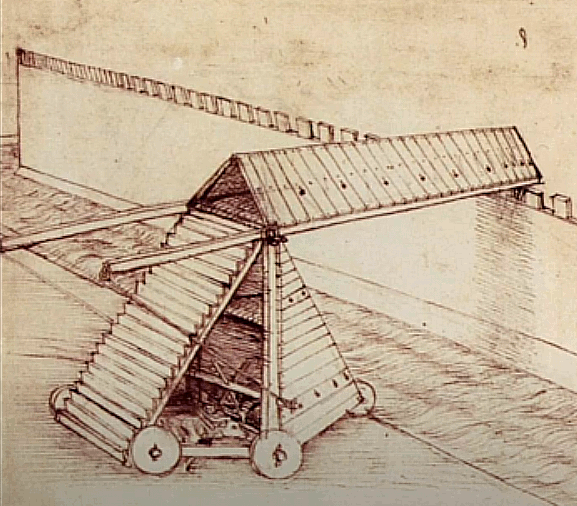
Fortify |
- Leonardo designed many inventions to help break
strongholds or fortify cities.
- After hiring Leonardo in
1502, Borgia moved
his court to the small but strongly built town of Imola,
originally constructed by Augustus.
|
While his early studies of fortified architecture were in line with the works of his contemporaries, Leonardo provided significant innovations in his graphic representations, using not only axonometric and prospect views, but also plan views, cutaway views, and horizontal sections. (Google
Arts & Culture)
|
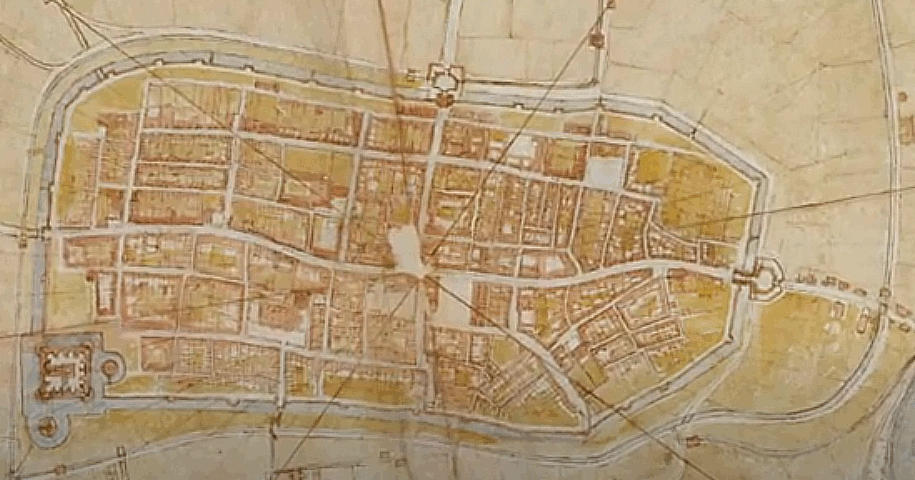
Imola center |
- Borgia wanted to fortify Imola to make it even
stronger and Da Vinci, Borgia
and Machiavelli were all holed up it this walled city
working on their own projects.
- It was during this time
that Da Vinci created the map of Imola.
- This is called
an Ichnographic map, meaning 'ichno' or 'tracing' such as an
outline.
- Borgia wanted Da Vinci to make maps because
they were very important in military matters.
- Military
commanders needed to know the lay of the land, important
places and potential weaknesses.
|
Leonardo's cartographic activity is largely concentrated in the period between 1502-1504, in the service of Cesare Borgia and the Republic of Florence, and 1515 in the service of Giuliano de' Medici. (Google
Arts & Culture)
|
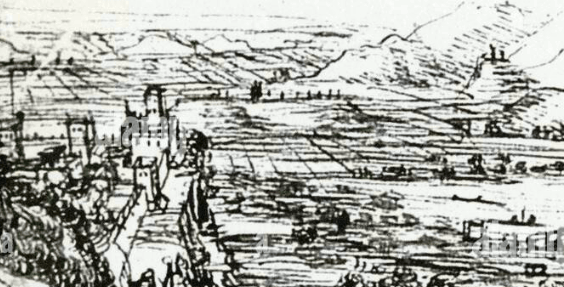
Three-dimensional perspective view
Earliest Leonardo - Florence 1473 |
- Most military maps during this period were created
from a three-dimensional perspective view, looking at a city
from outside the city walls.
- This would give you a view
of the heights of various edifaces in the city and these
type maps were used
so often because they provided a lot of practical
information.
- For one, milatary commanders could see
easily how to position themselves around the city, become
familiar with the terrain, and be able to visualize clearly
what to expect when they arrived there.
- Most Renaissance maps show buildings in elevation, or the
'oblique perspective.'
|
An oblique sketch has a more focus on the front side of an object or the face. Isometric Sketch focuses on the edge of an object. It is drawn usually using the 45-degrees angle to render the third dimensions. It is usually drawn using 30 degrees angles. (Assistant)
|

Contour map |
-
Compare this with a contour map where you pretty
much have to be a map reading expert to visualize the terrain
from one.
- The contour map offered the first aerial type
views, which were gathered from visits to mountain and hilltop
sites.
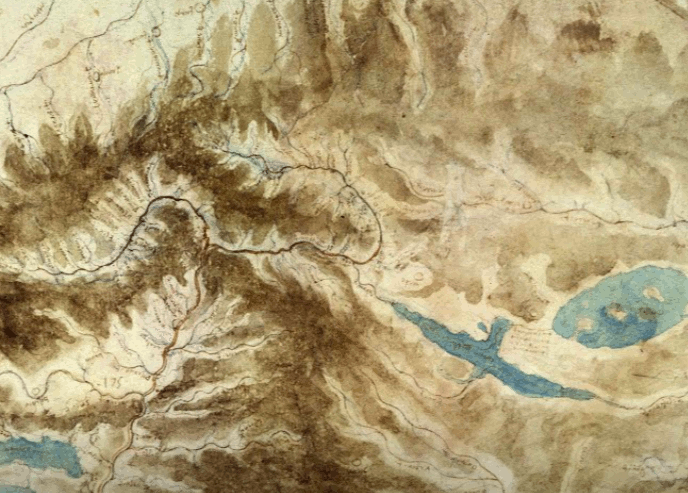
Agro Pontino 3D satellite view |
- Whereas a three-dimensional picture map is very
straightforward compared to a contour map.
- Leonardo's map of
Agro Pontino was fairly easy to read even though it had the
unique satellite view although it does have some elements of a
contour map.
|
To the first period date the maps of central Italy and
the Tuscan territory, drawn for military and
hydrographic purposes; some of them were specifically
drawn to elaborate the great project of navigating the
Arno. To the second period, on the other hand, dates
the beautiful map of the Agro Pontino, presumably
intended for the definition of the land reclamation
project desired by Giuliano de' Medici. (Google
Arts & Culture)
|

Leonardo bird's eye view map |
- The three-dimensional maps would also sometimes
emphasize certain parts of the city, making things like
churches and parks stand out more prominently.
- Some of
the major buildings would be made larger in order to point out
the importance of such places.
- This would give the commander
not just a spatial perspective on the surroundings, but also
some political and cultural insight shown by architecture
style and such things.

Earliest Leonardo - Florence 1473 |
- These maps were often sketches made by artists and
were a far cry from the mathematical precision in Leonardo's
maps.
- But these are
still very popular today usually as tourist souvenirs and
aiding visitors to find their way around and see what's
important in that area.
- The idea of a perfectly measured,
'objective' map wasn't something that was very common in Italy
before the Renaissance.
|
Alberti |
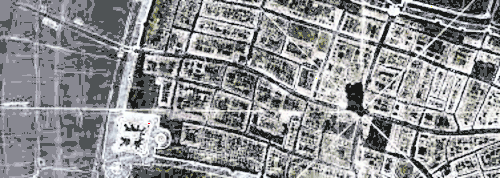
Imola google-type
satellite view |
-
Leon Battista Alberti, an Italian polymath who came a generation
before Da Vinci, wrote a treatise that described the
possibility of using a ccoordinate system to measure
distances.
- That was the idea of finding a central point
in a city and then added an angle, and distance from the
point, you could get accurate measurements anywhere.
- If
you gathered enough of these measurements, you would be able
to theoretically create a mathematically accurate map.
-
Alberti never actually produced any maps like this, but he did
accurately describe the method.
|
Leon Battista Alberti (1404-1472) was an Italian
Renaissance humanist author, artist, architect, poet,
priest, linguist, philosopher, and cryptographer; he
epitomised the nature of those identified now as
polymaths. He is considered the founder of European
cryptography, a claim he shares with Johannes
Trithemius. (Wikipedia)
|
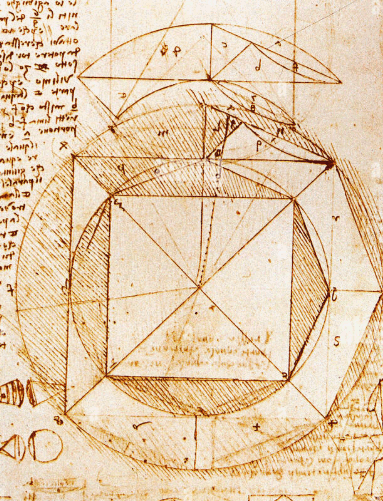
Geometrical studies by Leonardo Da VInci |
- Da Vinci certainly would have known about Alberti's
work, and he was definitely familiar with Vitruvius, who was
represented in one of his most famous drawings in 1487, the Vitruvian
Man.
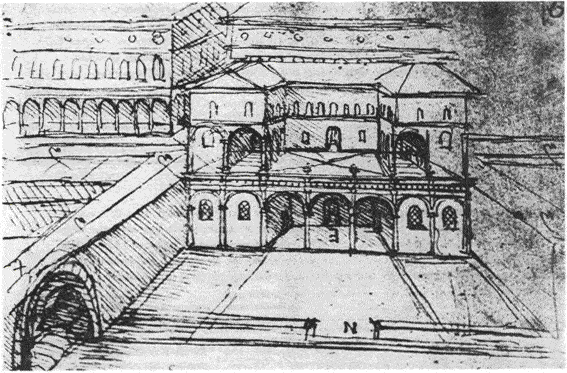
Projet De Ville Sur Deux Niveaus 1488
Leonardo's Smart City |
- Vitruvius had written about creating a 'rational'
city, where everything would be laid out according to specific
measurement and angles.
- Alberti had explained how to take
an angle at a distance in order to get an accurate point for
any location in the city.
- Da Vinci brought these ideas
together, combined with his artistic skills, to make a map
that was not only accurate, but beautiful.
- He applied his knowledge of science and art to his architecture and produced groundbreaking designs for residences, structures, and cities.
|
Da Vinci was born in the outskirts of Florence, Italy in 1452. He had seen how the plague had devastated his homeland in the century prior and blamed poorly designed, walled cities for the fast spread of the disease. Da Vinci addressed this in his proposed designs for cities, in particular, Milan. (Charlotte Lavery)
|

Map of Pisa - 1503 |
- Another elephant and mouth of the
Arno river.
- Created in 1503 when Da Vinci entered the
service of the Republic of Florence as a military architect.
- One of his first projects was to deviate the Arno at the
gates of Pisa in ordr to end the long siege of the city by
the Florentines.
- A dam near Riglione was intended to
block the flow and divert the water to a canal.
-
Strongly advised by Niccolò Machiavelli, the project was put in place in August 1504 with significant modifications from Leonardo's directions.
Despite measurements and inspections by water masters, the level of the Livorno Pond turned out to be higher than that of the Arno. In October a flood destroyed the dam and the river regained its bed, ending any further attempts to block its waters. (Google
Arts & Culture)
|
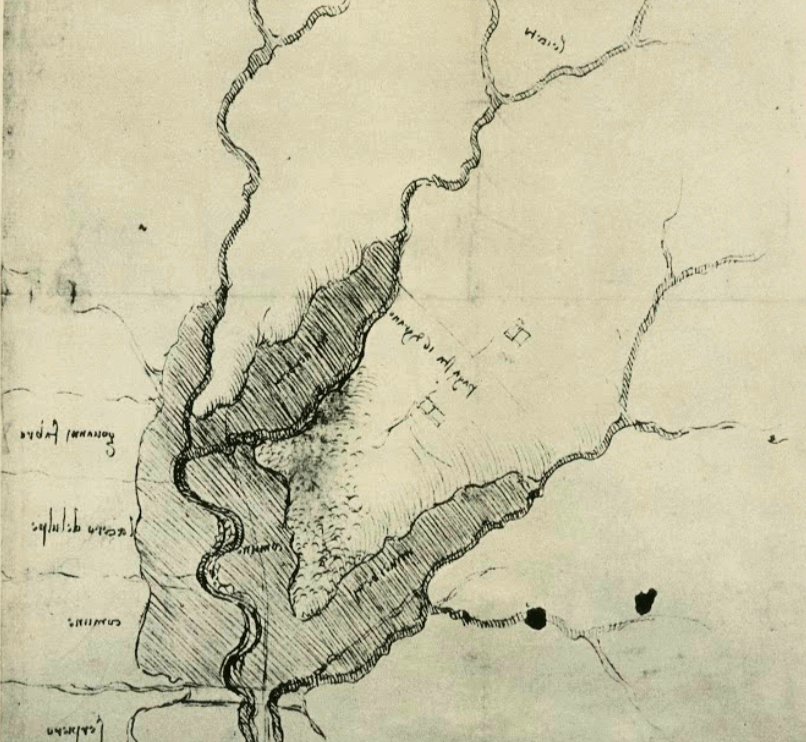
Map of
San Lorenzo Lake |
- The drawing shows the design of an artificial lake east of Vinci Castle in the Serravalle area
called the lake of San Lorenzo in Arniano.
- The lake would have been formed by the inflow of water brought by tributaries of the Streda and would possibly have served the activity of various mills in the area.
- Da Vinci mapped large sections of the Florence area in the
early 1500s for water diversion projects.

Protractor, compass and square rule |
- To make the Imola map, first Leonardo had to get good
measurements, so he used a number of different instruments.
- Angles were the most difficult because until the invention
of magnetic compasses became widespread, creating an
'objective' angle would have been extremely difficult.
-
It's been determined that he would have used a magnetic
compass, along with a wind compass, which marks directions
using the names of certain winds.
|
In the context of a compass, "objective angle" typically refers to the angle measured relative to a reference point, such as true north or magnetic north. This angle is used for navigation and surveying to determine direction. The angle measured clockwise from north is called azimuth. It's a common way to express direction, especially in navigation. (Assistant)
|
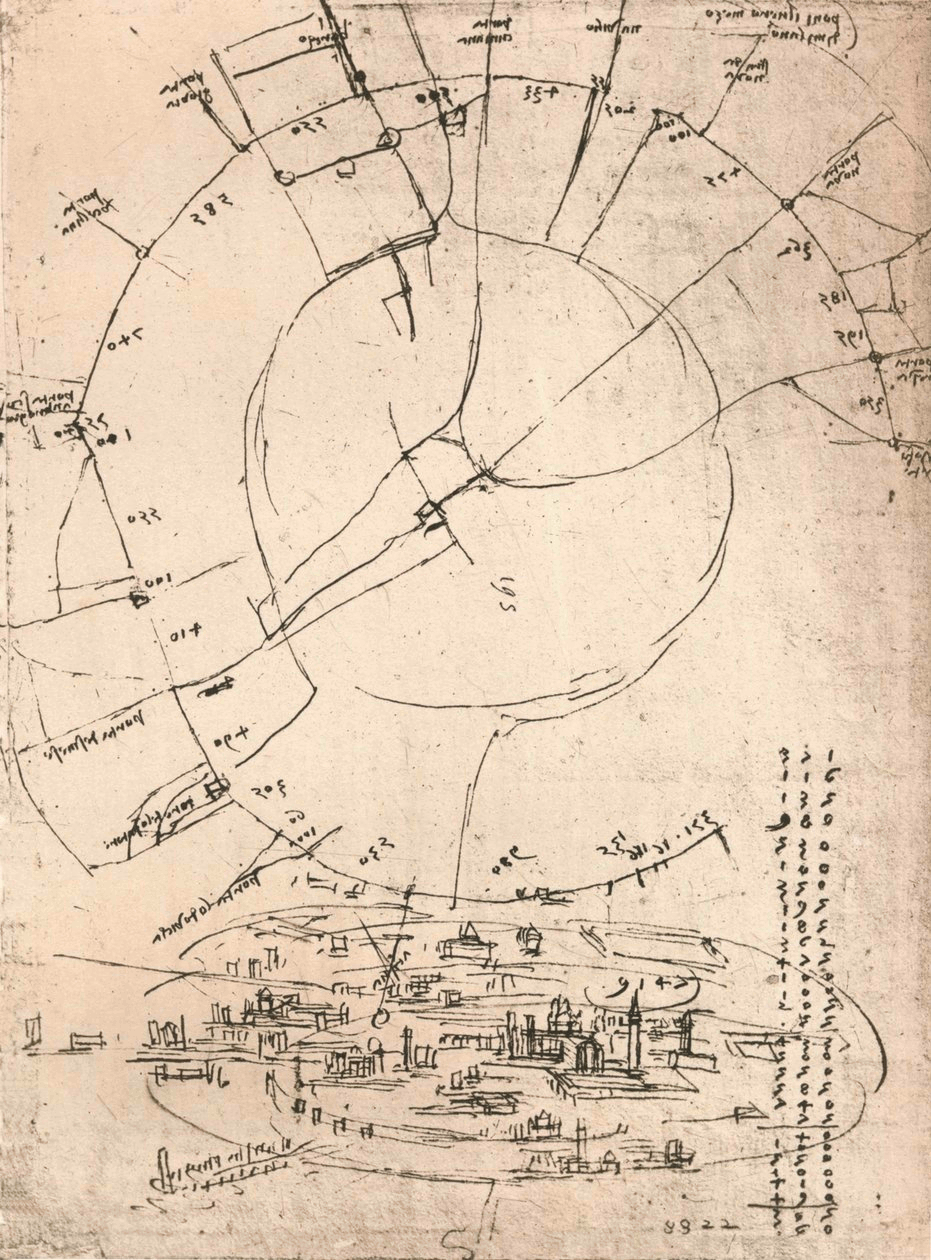
Leonardo perspective sketch |
- Leonardo built his ideas gradually, and over time,
finally came up with the concept of the map of Imola.
- In
earlier maps of Milan, it's apparent that he meshed multiple
map styles together on the same page.
- From his
perspective sketches, scholars have noted the precision of the
streets that Leonardo drew, compared to most perspective maps
at the time.
|
A "wind compass" refers to any tool or device that shows the direction and speed of the wind. These tools can be physical instruments like weather vanes or wind socks, or digital apps and websites that provide real-time wind data. (Assistant)
|
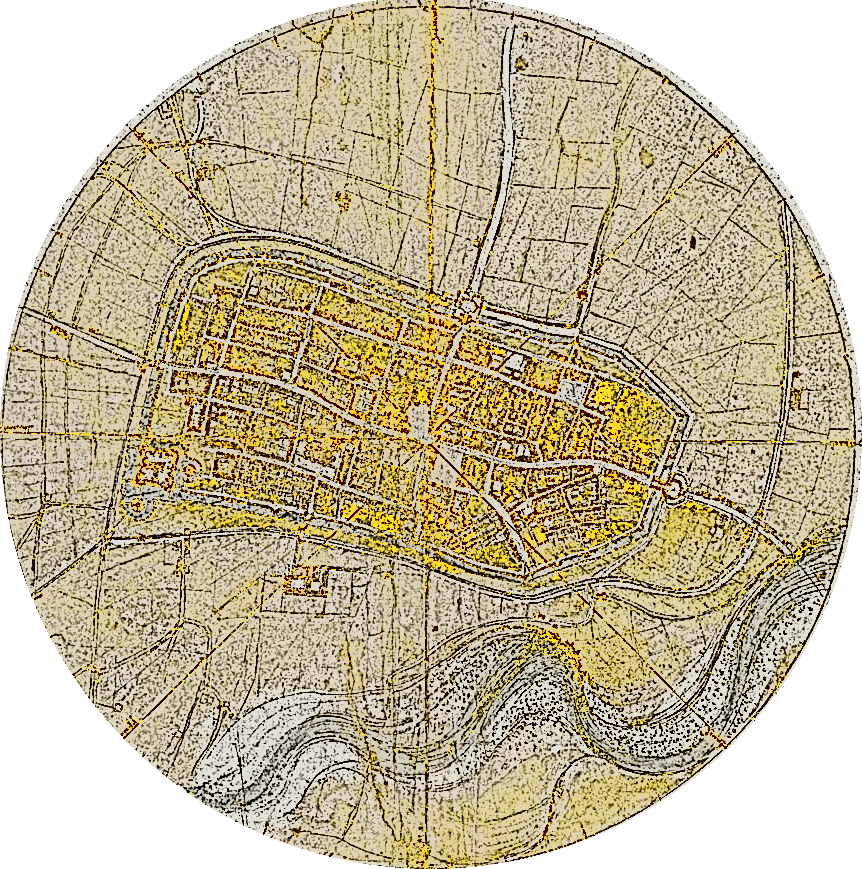
Imola angles |
- Using these two tools together, Leonardo could record
angles as needed and you can actually see the circle he
referenced, divided into slices, in the map itself.
- Wind compasses are no
longer in use, but they were used long before magnetic
compasses gave an objective, reliable angle to measure from.
- Oftentimes to measure distance, Leonardo would use an old
fashioned method and simply pace the length.
|
Leonardo cartographer From a hydrographic point of view, Leonardo's maps are the most detailed of the time, while on the level of representation they are distinguished by a three-dimensional rendering rendered effectively through the use of color, shading and bird's-eye perspective. (Google
Arts & Culture)
|

Leonardo''s hodometer |
- Leonardo also measured distances using a type of
hodometer, a tool that had been around for a long time, but he
made a few improvements.
- The device was designed like a
wheelbarrow, with a wheel in front, which would cause a rock
to fall into a sack everytime the wheel did a full rotation.
- After going from start to finish, you could count up the
stones and calculate how far the distance was.
- Leonardo
improved the tool by adding gears to make the measurement more
precise for his needs.
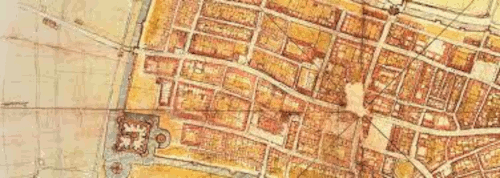
Imola close up |
- For all these measurements, Leonardo needed a central
point, and that can be seen clearly in the Imola map.
-
It looks much like a roumd pizza pie cut into pie shaped slices.
-
You can imagine Leonardo and his assistants, walking around
town taking notes, looking at their compasses, counting their
paces and pushing an hodometer like a wheelbarrow.
- In
fact, from some of the scraps of paper Leonardo left behind,
we can see that in every turn in Imola's walls, he marked the
angle of the next section of the wall, and the distance he
covered from the last turn.
|
Da Vinci centered the plan in a circle with four crossing lines, representing the points on a compass. And he showed the city ichnographically, “as if viewed from an infinite number of viewpoints,” perhaps inspired by his study of avian flight. It is the earliest such map in existence. (miscellaneousdetailstm.wordpress.com)
|
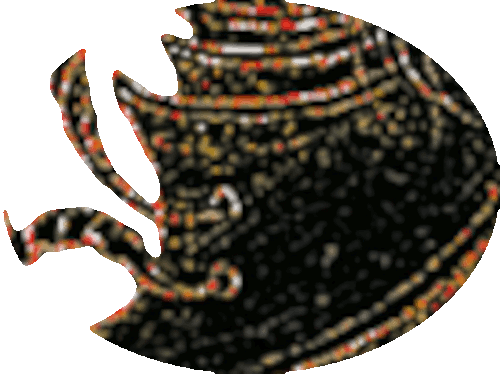
Counting steps |
- By taking these measurements and
carefully marking each turn, later, when he went back to his
desk, Leonardo could draw an exact map, to the scale he
desired, by following the angles and distances.
-
Undoubtably, the citizens of Imola were curious and amused by
an eccentric middle-aged man wandering around town and
counting his steps.
- There also seemed to be a romantic
angle to this map, that his love of birds and his obsession
with flight and flying machines, this allowed him to view the
world as though he could see if from above and he was able to
add that bird's eye view to his map.

Bird's eye view of bird nest |
- You might say it was the synthesis of
both intellecual ideas and passionate curiousity that gave Da
VInci the ability to make such interesting observations.
-
The final map that Da Vinci created is remarkable for a few
reasons.
- To begin, it's very accurate and current images
of Imola show the town has not changed much and many streets
and buildings are in the same place.
- There are a few
differences in that Da Vinci seemed to get a few of the angles
wrong, specifically the fort in the bottom left corner, which
doesn't align to the modern image, it seems to be at a tilt.

Set in stone |
-
There have been changes made to Imola so it's impossible to
pinpoint exactly where, or if, the map is inaccurate.
-
It's highly likely that someone today using modern
instruments, would be hard-pressed to do a better, more
precise job than Leonardo over 500 years ago.
- This map
was a work of art, and the copy we have today was found in
Leonardo's personal notes with crease lines, as if he had
folded it and carried it with him.
- Leonardo loved
detail and he colored all the walls and buildings and the
agricultural lines in the countryside.

Imola Santerno river |
- Leonardo also included a key with a list of nearby towns
and their distance.
- The most unique element in the map
is the Santerno river which is half-bird's eye view, half a
study in the nature of flowing water which was one of
Leonardo's most obsessive studies.
- He spent many hours
studying how water flows, the way it moves around objects,
how it bubbles and churns.
- Leonardo worked extensively
on plans for dams and canals.
- In the Imola map, the
water flows, you can see it's not just a line on a map, he
had to give it life showing a river with less static edges
than rivers today which are restrained
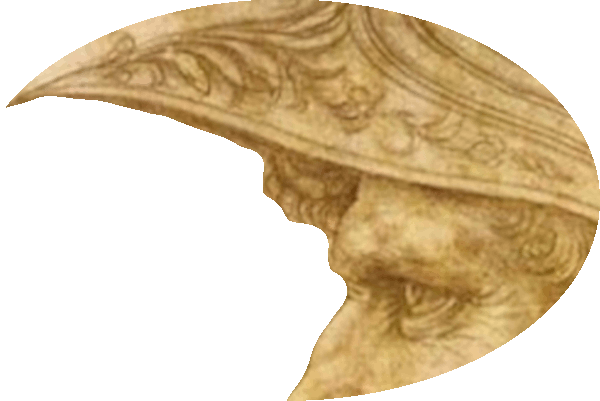
Chief military engineer |
- Da Vinci's map impressed Borgia and he quickly elevated
him to be his chief military engineer.
- Later, he created
a second map for Borgia of the Chiana Valley which was useful
while he worked on a dam construction project until leaving
Borgia's service the next year.
|
The ability to see the city from this perspective gave Borgia certain insights into the best ways to move around the city, where to post guards, how to make it stronger.
Beyond that, the mathematics and mind required to
create such a map was obviously useful to a military
leader. (Mapster)
|
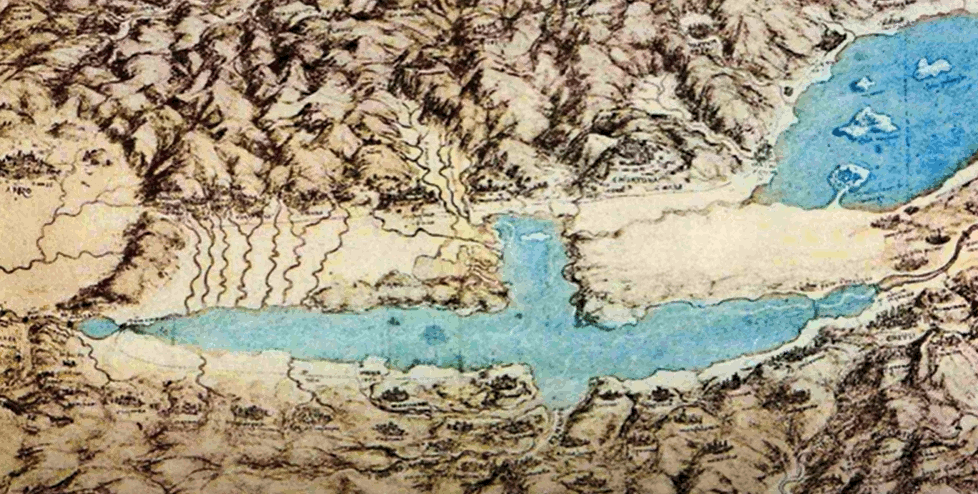
Chiana Valley map view |
- The Chiana Valley map was a return to
a pseudo-3D perspective drawing, useful for illustrating a
wide terrain.
- This map was a big step in a new say of
thinking about mapping and it's a beautiful piece of art, yet
it had virtually no impact at all on the actual development of
cartography.
- As far as we know, the map wasn't shared
with anyone.
- It wasn't written about, the methods weren't
discussed, and nothing ver got published or shared.
- Since Leonardo wasn't the only Renaissance man putting
together the pieces about ichnographic maps, the move forward
continued without his input.
Once you have tasted flight, you will forever walk the earth with your eyes turned skyward, for there you have been, and there you will always long to return. (DaVinci)
|

Mappamundi (World Map)
1508 |
- This is a unique world map drawn using the 'octant projection'
which is a type of map projection proposed the first time, in
1508, by Da Vinci in his Codex Atlanticus which was discovered in
the British Windsor collection.
- Da Vinci developed the concept of dividing the surface
of the globe into eight spherical equilateral triangles based
on his botanical drawings.
|
The map was originally documented by R. H. Major in his work Memoir on a mappemonde by Leonardo da Vinci, the earliest map Being Known hitherto container containing the name of America. (Wikipedia)
|
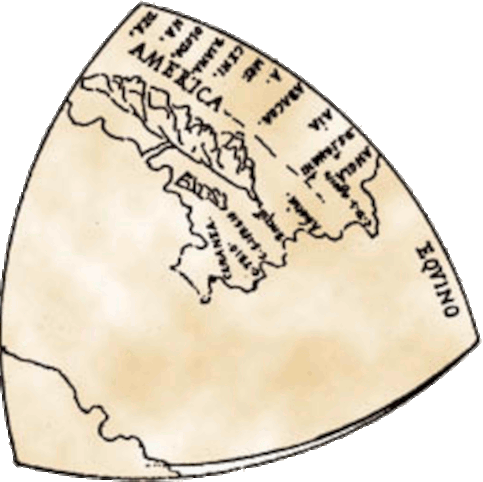
America slice |
- Each section of the globe is bounded by the Equator and two meridians separate by 90°.
- This was the first map of this type.
- It features an early use of the toponym America and incorporates information from the travels of Amerigo Vespucci, published in 1503 and 1505.
- Both the cosmographic and cartographic clues demonstrate that
Da Vinci knew about the fourth continent, to be named 'America' in 1507, less than a decade after Columbus embarked upon its shores.
|
Amerigo Vespucci (1454
-1512) was an Italian explorer and navigator from the Republic of Florence for whom "America" is named.
Vespucci participated in at least two voyages of the Age of Discovery between 1497 and 1504, first on behalf of Spain (1499–1500) and then for Portugal (1501–1502). In 1503 and 1505, two booklets were published under his name containing colourful descriptions of these explorations and other voyages. (Wikipedia)
|

mcapdevila, CC BY-SA 3.0 , via Wikimedia Commons
Modern reproduction of
Leonardo DaVinci - Map of America
1514 |
- Modern recreation of Leonardo da Vinci's world map to
show how it looks when pieced together in a globe.
- Additionally, the map depicts the Arctic as an ocean and Antarctica as a continent of about the correct size.
- Richard Henry Major, who first published the map in 1865 and defended its authenticity, dated it around 1514 because Florida is drawn as an island with the name of TERRA FLORIDA.
|
Finally, Leonardo engraved his notion of this
new continent on an ostrich egg globe (now known as
the Da Vinci Globe) and made a copper cast of this.
Both the cosmographic and cartographic clues
demonstrate that Leonardo da Vinci knew about the
fourth continent, to be named “America” in 1507.
(Royal Geographical Society, London)
|
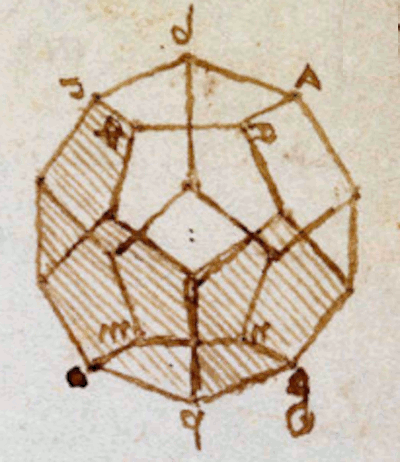
Seeing the world from above |
- Raphael, another famous
painter, was working on an overhead plan map of Rome when he
died prematurely at age 37 and his work was carried forward by
others such as Bufalini in the mid-1500s.
- Bufalini
created a variety of overhead views of cities, some with 3D
terrain alongside ichnographic tracing and many others were
involved in the history of this type of early mapping.
-
The map of Imola, seeing the world from above, was something
that Leonardo saw in his mind and he just had to find a way
to put it on paper and did so very successfully.
|
While Leonardo's map is the first ichnographic map, it's hard to call it a 'step forward' in mapping, since no one took the step with Leonardo.
In some ways, Da Vinci was too busy learning and
innovating to take the rest of the world along with
him. It does leave you wondering if his work on other
subjcts as well, had been published an shared, how
would we think of him today? And how much would
humankind not have had to discover again? (Mapster)
|
|
Sacred Geometry is Art |

Geometric flower |
- Sacred geometry goes way back to ancient times to Egypt.
- Da Vinci utilized the Flower of Life’s sacred shape and its mathematical properties.
- He actually drew the symbol and variations of the symbol such as The
Seed of Life.
- Additionally, he also used the golden ratio of phi in his artworks, which all may derive from the
Flower of Life
symbology.
- Leonardo combined all the geometries, Flower
of Life and Seed of Life into one amazing diagram.
- Here a
group of hexagons are added to each circle creating a grid of
dodecagons and triangles.
|
Within the Vitruvian Man artwork/schematic there not only exists the more overt (widely accepted) depictions regarding Sacred/Divine Geometrical symmetries & patterns more clearly observable to the physical realm, but that the schematic also contains more covert (or enigmatic) messaging regarding such symmetries & patterns Leonardo da Vinci may have resolved existed in realms to the non-physical. (Craig Matheson)
|

Tomruen, CC BY-SA 4.0 , via Wikimedia Commons
Flower of Life with 19-circles and 27 spheres |
- The Flower of Life consists of an overlapping circles grid
in a geometric pattern of repeating circles of an equal
radius in a two-dimensional space.
-
Leonardo was captivated by the geometric principles of the
Flower of Life.
- He incorporated it into his collection of images and notes known as
Codex Atlanticus.
- It is a mathematical ratio
or proportion system and above the diagram, Leonardo wrote
the Fibonacci sequence.
- It is not only based on
Fibonacci numbers, but it can create all geometry in the
universe.
- Created by a compass and straight edge, the
Flower of Life can be used as a circular grid system.
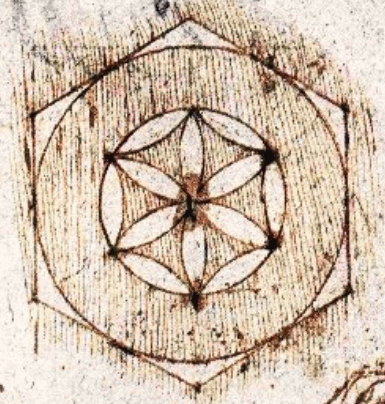
All geometry in the universe |
- The Flower of Life pattern is the key to all sacred
geometric systems.
- Jewish geometry Kabfalah, Tree of
Life, may be based on Hellenistic Judaism that was influenced
by Greek culture and sacred geometry.
- The pattern was
created by Leonardo Bonacci Fibonacci (1170-1250) also known
as Leonardo of Pisa who was the most talented Western
mathematician of the Middle Ages.
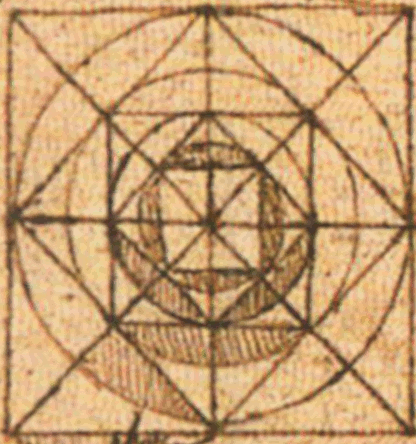
Metatron's cube |
- Metatron's cube has become a secret occult symbol
based on the Archangel Metatron.
- Angels in the Bible
look like geometric figures and Metatron's cube in sacred
geometry represents the map of all creation.
- The five
platonic solids are contained in the cube which are thought
to be the building blocks of the universe in Platonic and
Neoplatonic theory.
- Circles and lines are believed to
form all known shapes in the universe and Metatron's cube is
formed from the Flower of Life diagram.

Cube design |
- The cube
defines our experience of space with its faces corresponding
to forward, backward, right, left, up and down.
- It also
corresponds to the six directions, north, south, east, west,
zenith and nadir.
|
In the horizontal coordinate system used in astronomy, north, south, east, and west are the cardinal directions on the horizon. Zenith is the point directly overhead, and nadir is the point directly below your feet (opposite the zenith). (Assistant)
|
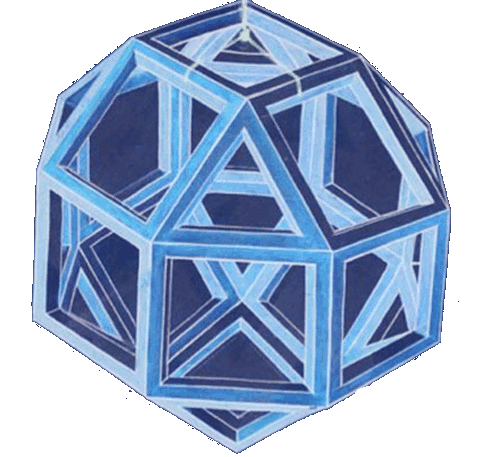
Platonic solids |
- The five platonic solids can be formed by Metatron's
cube.
- Platonic solids are five specific types of polyhedra where all faces are identical regular polygons and the same number of faces meet at each vertex.
- They are the tetrahedron, cube, octahedron, dodecahedron, and icosahedron.
- Plato associated these solids with the fundamental elements of the universe: fire (tetrahedron), earth (cube), air (octahedron), water (icosahedron), and the cosmos (dodecahedron).
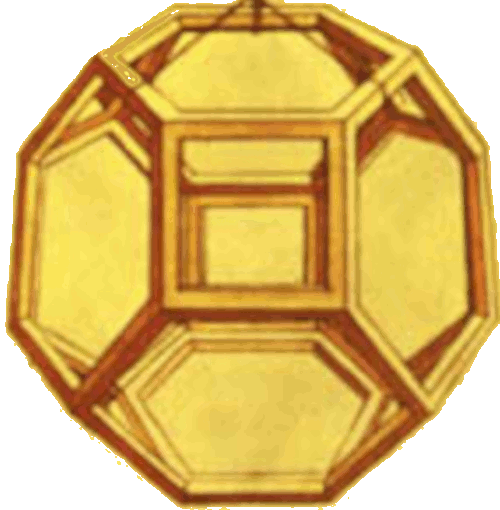
Plato and Atlantis |
- Plato first wrote about platonic solids in his book
Timaeus
in 360 BC but they existed long before Plato wrote about them.
- Since Plato also discussed Atlantis in Timaeus,
some speculate this geometry was discovered in Atlantis where a
universal science of geometry existed.
- And that the
knowledge of geometry, science and mystiism was lost to the
ages but can be relearned by studying sacred geometry.
-
Leonardo drew his solids as skeletonics or what we would call
wire frames to show the front and back views at the same time.
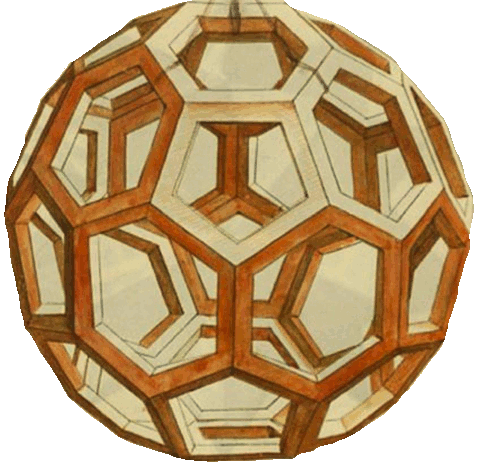
Dodecahedron |
- Plato was the first to write about platonic solids.
- Dodecahedron was called the sphere of 12 pentagons by the
Pythagoreans.
- Plato wrote that there remained a 5th
construction which God used for embroidering the
constellations on the whole heaven.
- This enigmatic
statement implies that the geometry of the pentagon is the
basis of the astrological chart and people have interpreted
this as corresponding to the ether, or spirit.

Flowering Seed of Life |
- Three circles produce triangles and hexagons and can
lead to a whole universe of geometries.
- They were used
extensively in creating tracery patterns and arches in
architecture.
- Six circles around one produce the Seed
of Life and this is in the Bible where God created the world
in six days and on the 7th day he rested.
- The outer 6
circles would represent God creating the cosmos from points
that can become circles, while the inner circle represents
the 7th day of rest.

Seeds of life |
- Seed of Life comes from Euclid's construction of a
hexagon which is created from drawing arcs with the compass
from the outer edge of the circle through its inner points.
- In Euclid's Elements all two-dimensional figures
can be constructed using only a compass and straight edge.
- Euclid did not inherently create it as a mystical symbol
as we know it today, but just a proof based on basic
geometry.
- Because people don't draw with a compass and
straight edge anymore, it appears magical.
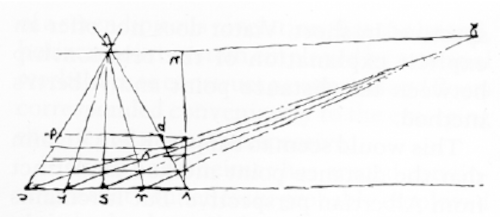
Leonardo's perspective with vanishing point |
- Perspective was a form of design in geometry in the
Renaissance, not just a trick to make things look
three-dimensional.
- This was thought of as Renaissance
invention, however, Plato described in his book Republic as
early as 375 BC.
- It is important to understand the
difference between proportions, geometry, formal
subdivision, grids and compass and ruler construction, they
are all related concepts but slightly different.

Proportions |
- Proportions are relationships of parts to the whole
and are mathemation ratios.
- The Greek word for ratio is
logos which also means the cosmos, or divine mind of God.
-
Proportions exist in music, mathematics, geometry, art and
architecture.
|
The spiritual idea was 'As above, so below' meaning
the proportions of the human body correspond to
heavenly proportions of the cosmos. Man's body
represents heaven and the body is the temple of the
soul. When repeated in architecture it reinforces the
idea that human and divine proportions are One. (Roberts Architecture)
|
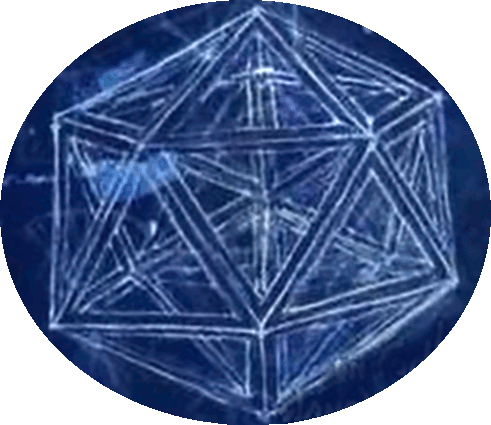
Geometry |
-
Geometry are shapes both two-dimensional and
three-dimensional.
- The most basic of these are the
circle, triangle, and square, however can include any shape.
- Polyhedron is a Greek word meaning many angles and relates
to three-dimensional shapes.
- Geometry can be mathematical
too, it's practical application can be found in art,
architecture and science.

Formal subdivision lines |
-
Subdivision refers to partitioning a mathematical object
into smaller, constituent pieces, much like dividing a piece
of real estate.
- Formal subdivision or dynamic symmetry is
using lines to divide a form.
- This was often used in art
and architecture and it's difficult to determine if artwork is
using formal subdivision, proportions or geometry to control
the design.
- This becomes even more difficult to determine
in architecture as controlling lines were used
in the construction process.
- Architects and builders
would use these lines to make sure the building was level and
the horizonal lines were plumb.
|
A plumb level is a tool used to measure the vertical alignment of a surface or object, ensuring it's perfectly upright or straight up and down. It's the opposite of a spirit level, which measures horizontal alignment. (Assistant)
|
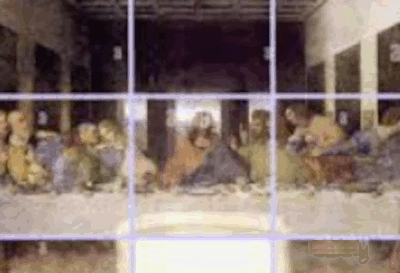
Grids |
- Grids were also used in art and architecture although
it's sometimes difficult to determine if a building is
designed on a grid, or if it's using proportions, geometry or
formal subdivision.
- This method is especially helpful if
you are using a reference photo and want your drawing to have
equal ratios as the photo.
- For instance if you want a 2"
x 4" photo to have the same ratio when you move the design to
a larger piece of canvas, using a grid will help insure
everything will be in the correct place.
- It involves drawing a grid over your reference photo and then drawing a grid of equal ration onto your canvas, paper, or other substrate.

Ruler and compass method |
- The tools of the architect and stonemason were the
ruler and compass.
- This was used not only in stonemasonry
but also to draw the design of the building.
- Here it is
impossible to know if the artist was simply drawing circles or
squares, or if there was more to their mathematical understanding
as in Da Vinci's Vitruvian Man.
- The ruler and compass is
the well-known symbol for Freemasonry and the G represents
Geometry as they believe 'God' is the grand architect or
geometer of the universe.
- This is still studied to this
day and many famous people were Freemasons.
|
Geometry was considered paradigma, or the underlying pattern or archetype and the Divine Creator was seen as an architect ordering the cosmos by number. (Roberts
Architecture)
|
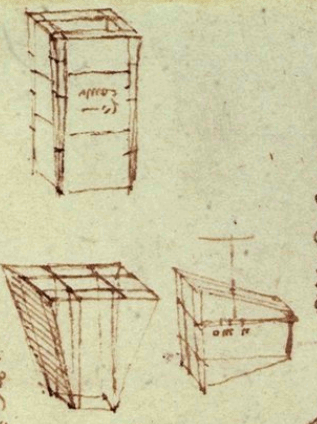
Symmetry in architecture |
- There are two types of symmetry in art and
architecture; static and dynamic.
- Static symmetries copy
a form around a central axis and they can also be created by
grids and modules.
- Dynamic symmetries use diagonal lines
to create the feeling of movement and rhythm.
- This technique involves using controlling lines and axes derived from geometric shapes like squares and rectangles, often incorporating the golden ratio, to establish proportions and guide the placement of architectural elements.
- Plato was the first to discuss dynamic symmetry in the
4th-century BC, but the Egyptians were first to use this
technique.
|
Dynamic symmetry in architecture is a system of proportions based on root rectangles (like √2, √3, √5, and the golden ratio) and their relationships, used to create visually pleasing and harmonious designs. It's not just about static symmetry, but a dynamic interplay of lines and proportions that suggests movement and life. This system was used in classical Greek and Roman architecture and was later rediscovered and applied by Renaissance artists and architects. (Jay Hambidge)
|

Leonardo da Vinci, Public domain, via Wikimedia
Commons
1495-1498 |
-
Around 1495 Da Vinci received a commission from Ludvico Sforza, Duke
of Milan, to decorate Dominican monastery Santa Maria delle Grazie and
he set about what would become one the most powerful works of art of western culture, The Last Supper.
- He created the effect that the room in which Christ and the apostles are seen was an extension of the refectory.
- Leonardo utilizes the inherent properties of the number
12; there are 4 hangings on each side wall and 3 windows at the end wall.
- There are 6 men on each side of Christ, who seems to be
alone and resigned to his fate.
|
In terms of geometry twelve is a pentagonal number. The dodecahedron, mysterious Platonic solid, has twelve faces. Regular cube and octahedron has twelve edges, while icosahedron has twelve vertices. (renaissanceperspective.eu)
|

Central point on the horizon |
- The fact that Leonardo was known for his love of symmetry is evidenced by the overall design of the painting.
- For this painting he uses a grid to focus the
perspective of the room to one central point on the horizon
and create the illusion of depth.
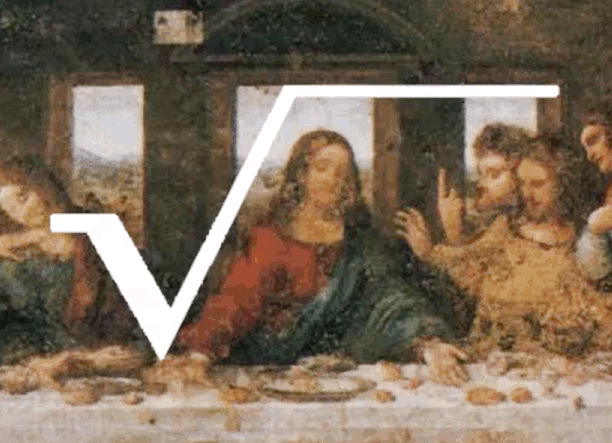
Square root serpent |
- Notice how the floor is divided into the (now faded) yellow stripes, which are precisely proportioned by the Golden Ratio and are the integral part of the sacred geometry.
- Leonardo was among the first, if not the very first, to successfully apply the principles of the Renaissance perspective to a work of art.
- Recent interpretations suggest that a hidden square root symbol, visualized as a serpent, interacts with the apostles and their gestures.
- This reveals a sophisticated geometric and symbolic structure within the painting
as the symbol is turned different directions.
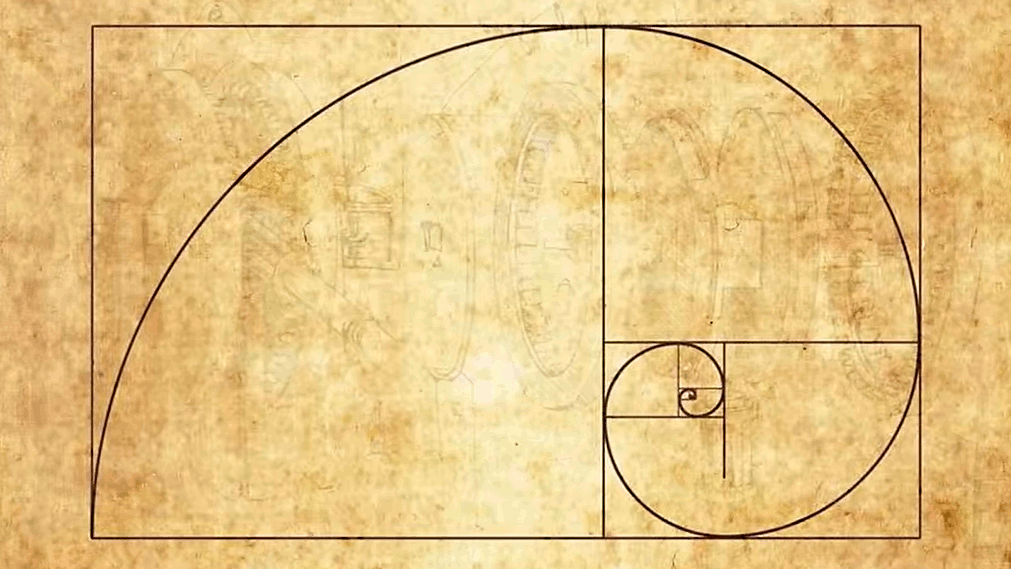
Da Vinci & Fibonacci
Golden section
spiral |
- Da Vinci designed his famous
painting, the Annunciation based on the Fibonacci curve, like
all his art, although it was a subliminal skill something he
did automatically in his mind.
- He did this by first drawing a square around
the Virgin Mary and then drew a golden section triangle,
sometimes called a root 5 rectangle.
- He used a compass to
inscribe an arc from the corner of the square and repeats the
golden rectangle.
|
A root 5 rectangle is a rectangle where the ratio of the longer side to the shorter side is equal to the square root of 5 (approximately 2.236). It's a type of rectangle with unique properties related to the golden ratio and can be constructed from a square.
(Assistant)
|
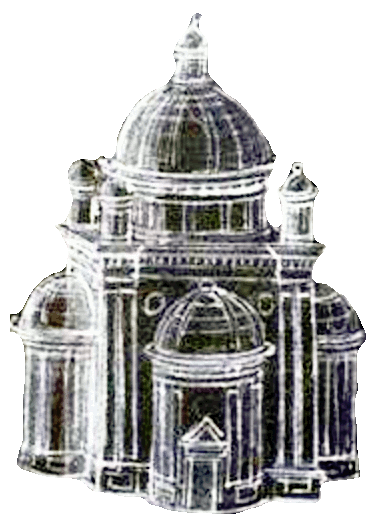
The end plan |
- This is an largely unknown technique called 'rebatment'
where Da Vinci created two overlapping squares in a rectangle
and the fibonacci geometric design helped him design balance.
- The picture is divided into one large
square on the right, and two golden rectangles on the left and
the golden section is used in the positioning of the trees and
mountains.

Andrea Palladio, the Villa Almerico-Capra
La
Rotonda |
- Designed by Andrea Palladio, the Villa Almerico-Capra, commonly known as La Rotonda, would become one of the most recognizable buildings of the Renaissance.
- Palladio uses the golden section rectangle and overlaid it
similiar to the rebatment technique, but instead of using a
square, he used a golden rectangle.

Golden section rectangle |
- Tbe golden section rectangle is used extensively in
art and architecture.
- It is created by taking the
midpoint of a side of a square and using it as the center of
a circle.
- Using a compass one then draws an arc from one side of the square.

Extreme and mean ratio |
-
The first documentend golden section rectangle is
constructed in Book two of Euclid's Elements.
-
Euclid calls it the 'extreme and mean ratio.'
- Later, Luca
Pacioli called it the divine portion and in the 18th-century,
mathematician Martin Ohm called it golden section and this
term has been used ever since.
- The golden section
rectangle can be used to create the golden section spiral
which has been used extensively in art and is based on the
Fibornacci sequence.
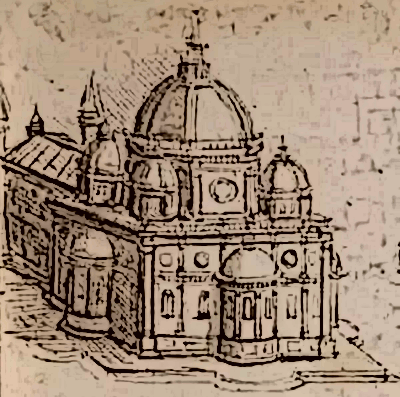
Florence Cathedral |
- Da Vinci used this Golden Ratio geometry in all his
architectural designs as well.
- He was among many prominent artists of the Renaissance, with the other
being Filippo Brunelleschi.
- These two artists were able to create
remarkable works of art that were well beyond their time.
- The link between the two is credited to the dome of the
Florence Cathedral and the bronze ball placed on top was commissioned to Verrocchio
when Leonardo was
his apprentice.
|
It is said that da Vinci was obsessed with Brunelleschi’s machines that
were used to hoist the ball and he made a series of sketches of them. Although they were
years apart, they were both great inventors and artist of their time that focused on process
and how things related to each other.
(halliemeredith.net)
|

Milan Cathedral |
- Leonardo was involved in the redesign of the Milan Cathedral where he proposed a new dome to be built.
- In his sketches, he included the plans for the dome as well as the layout and internal structures that exhibited his vast knowledge of engineering.
- However, his plan was not chosen for the project and
that is something architects had to learn to bear, especally
after spending a lot of time on a detailed design.

Da Vinci
residential staircase
Landlords and servants |
- Da Vinci designed a double helix staircase for King Francis I
of France, who appointed
him as 'First Painter, Architect, and Engineer to the King.'
- While living in the Chateau du Clos Lucé, Da Vinci drew inspiration from a snail for his model of the staircase and produced what is now thought to be one of his masterworks of design and engineering.
- Da Vinci designed a double helix 'DNA' staircase inside the Château de Chambord
in France in 1516.
- This staircase is unique because it consists of two intertwined spiral staircases that allow people to ascend and descend without obstructing each other.

Planet
perspective |
- Da Vinci's theory of cosmology concerns the relation of the sun, earth and moon to one another.
- But without a telescope, he had to reach his conclusions on the structure of the moon by applying his knowledge of optics and perspective.
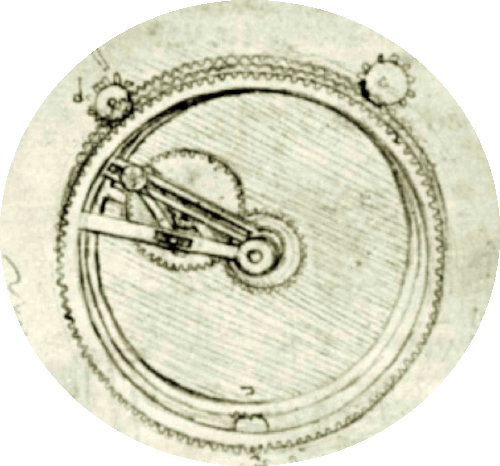
Dial of Venus |
- Leonardo’s immense intellectual curiosity and advanced power of observation would lend a hand to many of his astronomical findings but most importantly, his design of a telescope,
although he never built it.
- His design of a possible telescope is not widely known so, the concept is attributed to Galileo Galilei.
- The Dial of Venus and the sun is a sketch of an astronomical
clock.
|
Distinct from the dominant view at the time, Leonardo believed that the moon has no light of its own, but reflects sunlight because its surface, like the earth, has seas whose waves reflect sunlight.
(Google Arts & Culture)
|

Spheres of the elements |
- A sketch tht represents the spheres of the elements, as they were popularly conceived in Leonardo’s time.
- The earth in the center, then the water, air, and fire.
- The small circle “o” represents the forces of motion and gravity.
|
All things perish. (Da Vinci)
|
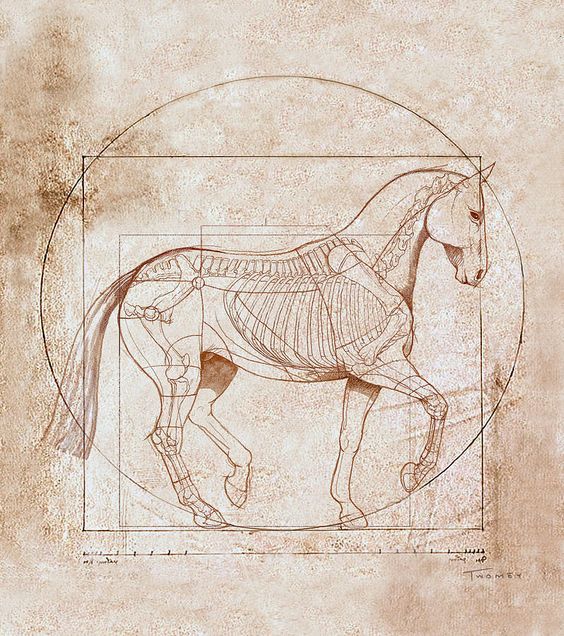
Equine anatomy |
-
Da Vinci studied the movements as well as the skeletal structures and their muscles
of animals like oxen, horses and birds.
- He also had an obsession with the human body
and how it worked but prior to 1506 his representations had been inaccurate.
- His studies of
anatomy began in late 1506 when he began dissecting a 100 year old man who he
witnessed passing away.

Anatomy |
- He not only wanted to know how the body worked, but also
where emotions came from and in order to figure this out he dissected muscles, nerves and
vessels and recreated them within his drawings.
- This allowed him to understand how
blood flowed throughout the body.
- His drawing of the fetus inside of a uterus was the fist
correctly depicted fetus in its proper position.
- To this day some of his sketches are still being used
in anatomy classes.

Measurements and proportions |
-
After he finished his anatomical studies, Da
Vinci then went on to study measurements and
proportions of the human body.
- Based on the analogy between the macrocosm an the
microcosm, the body of earth and the body of man, Leonardo was
convinced that water circulates in the earth like blood in the
body.
- He studied how water acted like a sculptor on the
rivers and valleys it passes through and became meandering
over time and the water eroded the riverbanks and bottom.
-
We learn most of all that mathematics is our world and it's
not a human discovery but a sacred and mystical organizational
principle of the cosmos.
|
His goal with this drawing was to bring together the ideas of art, architecture, human
anatomy and symmetry in one remarkable image.
(halliemeredith.net)
|
|

